
- 0548 818 0 278


Article Royal Cyprus
We use cookies and Inspectlet. By using this website, you accept the use of cookies which helps us provide you more interesting and adapted content.
A historic wedding
Traces of the past and the tumultuous history of Cyprus dot the land, creating an amalgam of traditions, stories, architecture, art, and culture. This is a land where medieval knights, kings, queens, cardinals, merchants, orthodox bishops, and farmers once walked the same streets and breathed the same air. This amazing and colorful crowd left its mark on enduring traditions and the island’s surviving medieval buildings and art.
A visit to the Castle of Lemesos (Limassol) , which today houses the Medieval Museum of Cyprus, will give you a sense of the flair of the crowd that roamed the land in medieval times. The Castle is linked to a well-known royal wedding, that of Richard the Lionheart and Berengaria.
In 1185, Berengaria was given the fief of Monreal by her father. Eleanor of Aquitaine promoted the engagement of Berengaria to her son, Richard the Lionheart. An alliance with Navarre meant protection for the southern borders of Eleanor’s Duchy of Aquitaine and would create better relations with neighboring Castile, whose queen was a sister of Richard.
Richard had Berengaria brought to him by his mother, Eleanor of Aquitaine. Because Richard was already on the Third Crusade, having wasted no time in setting off after his coronation, the two women had a long and difficult journey to catch up with him. They arrived at Messina, in Sicily, during Lent (when the marriage could not take place) in 1191 and were joined by Richard’s sister Joan, the widowed queen of Sicily. Berengaria was left in Joan’s custody. The two ladies boarded a ship and set off to find Richard.
En route to the Holy Land, the ship carrying Berengaria and Joan ran aground off the coast of Cyprus, and they were threatened by the island’s ruler, Isaac Comnenus. Richard came to their rescue, captured the island, and overthrew Comnenus. Berengaria married Richard the Lionheart on May 12 th , 1191, in the Chapel of St. George, located within the Castle of Lemesos (Limassol), and was crowned the same day by the archbishop of Bordeaux and bishops of Évreux and Bayonne.
Berengaria is known as “the only English queen never to have set foot in the country” since this was the first time a Queen of England was crowned outside the borders of the country.
Rumor has it that a sumptuous meal followed the marriage and coronation ceremonies. The guests were offered some of the grapes for which the island was famous. When Richard the Lionheart tasted the grapes, he said they were “very good,” so the name stuck with this table grape variety which, since then, has been known as verigo , from the words “very good”.
Try the verigo grapes and rest assured that their unique flavor will leave you feeling like royalty!
The Castle of Lemesos (Limassol), site of Richard the Lionheart’s wedding
The medieval museum of cyprus has a vast array of artifacts, the very good verigo grapes, things to consider before traveling, how to choose your accommodation in europe: a guide.
In Europe, there is accommodation for every wish, price range, and desired experience. Whether it’s a tent suspended between two trees, a five-star hotel with a view of a turquoise sea, or a wallet-friendly hostel, it’s all here. The question is, what specific options do you have and how do you go about choosing? That’s […]
The ultimate guide to European currencies
How to convert cash, use cards, and reduce fees One of the great benefits of traveling around Europe is the ease of use when it comes to currencies. On much of the continent, you don’t need to worry about keeping different bills and coins or making mental-math conversations between one currency to another to […]
How to stay safe while traveling in Europe
No matter what, safety while traveling is most important. Luckily, Europe has a stellar safety record, and more than a dozen of its countries regularly appear at the top end of safest places to live and travel lists. To make your adventure safe and secure, consider these tips and best practices! Travel insurance […]
What you need to enter Europe
Visas, documents, and passports So, you are planning to visit Europe. Great! We will be happy to welcome you and share what makes this continent so unique. Here are answers to the most common questions about preparing for your trip. Addressing them now will make your travels smooth, easy, and convenient! Who needs a […]
Your complete guide to planning your daily life in Europe
Tips on local languages, mobile tech, and time zones We all know the feeling: your phone battery is dying or you’re passing through an area of weak signal. At home, it’s usually a simple annoyance, but when you’re traveling, not having access to a communications device is something you’ll want to avoid. So, how […]
Some tips to consider while traveling
Traveling around europe.
Your guide to trains, trams, busses and bikes Europe has one of the most advanced transportation systems in the world. From massive metropolises to small towns, you can easily link up from place to place by public transport. Riding the rails across this marvelous continent might be the best way to explore: it’s highly efficient, […]
Tips to communicate in Europe
Why speaking a few words of the local tongue will make your travel experience even better As you may have guessed, English is widely spoken in Europe, especially in northern countries. In many other countries, people have a good, if not fluent, grasp of the language. But that doesn’t mean that learning—and indeed using! […]
Your guide to passenger rights while traveling in Europe
If you’re a traveler, you’ve probably experienced a delay, cancellation, or other unforeseen issue. Of course, no one wants this, but it’s important to be prepared and perhaps most of all, to know your rights and privileges if a problem arises. So, what are your rights in Europe? Keep reading! Air Passenger Rights So, […]
Wildlife adventures in Latvia
Explore fantastic national parks!
A coffee cup full of tradition
Follow the Historic Cafés Route!
San Marino Christmas
A wonderful, magical atmosphere.
The King of Landforms
The most majestic of all landscapes is the fjord, a glacial formation that carves out deep, narrow valleys filled with sparkling waters. High walls preside over the water, providing spectacular views and excellent hiking. Although there are many glacial features that resemble fjords throughout the world, the truest and most beautiful fjords can be found in Europe.
Want to know more about Europe?
Sign up to our newsletter here:
http://visitcy.com
Cyprus Royal
Avrupa standartlarına ve ECTAA prensiplerine uygun olarak, profesyonel operasyon ekibimizle , üstün kurumsal imajımız, ve itibarımız ile güçlü olduğumuz bu sektörde hizmet vermek adına, geçtiğimiz yıllarda Türkiye ve Kıbrıs’ın en güvenilir ve en istikrarlı turizm kuruluşlarında görev yapmış birçok üst düzey yönetici ile CYPRUS ROYAL TOURISM bünyesinde toplanarak, kurumsal yapılanmamızı tamamlamış bulunmaktayız.
CYPRUS ROYAL TOURISM , bilişim teknolojilerinin sunduğu imkânları doğru kullanarak, marketler arası bir aktivite kazandırmayı ve global bir turizm hareketi yaratmayı ilke edinerek, 2018 yılı itibariyle yeni bir oluşum ile kişi ve kurumlara özel servis anlayışıyla kurulmuştur.
Turizm sektöründe kalitenin anlamını vurgulayan, sunduğu hizmetlerle müşterilerine kalitenin vazgeçilmezliğini ispatlayacak, global bir CYPRUS ROYAL TOURISM markası yaratmak.
Sektördeki kalite belirleyicisi olarak, işbirliği yapılan firmalarla karlı sonuçlar yaşayan, müşteri memnuniyet garantisinin birinci görev olduğu kaliteli hizmet ve liderliğin sürekliliğini sağlayan bir kimliğe sahip olmak.
Bilgi , tecrübe ve yeteneğin kalite kriterlerini oluşturduğu, doğru ve stratejik planlama ile pazar lideri olan, kurum içi sinerji yaratan yüksek değerlere sahip bir kurum olmak.
Kaliteden ödün vermeden, gerekli yatırımları gerçekleştirebilmek, yeni ürünler geliştirmek ve farklı marketlerde uygulamak, faaliyetlerden kaynak yaratmak ve tüm kaynakların akılcı kullanımını sağlamak, tüm ilişkilerde adilane, ticaret yaptığı ortaklarına yarar sağlamak amacıyla, iyi niyet ve güven duygusuyla, yasalara ve ahlak kurallarına koşulsuz uyarak, insanlığa ve gelecek kuşaklara karşı sorumluluğumuzu yerine getirmek, gelecekte de öncüsü olacağımız ilkelerimizdir.
Kalite vazgeçilmezdir.


Home » Travel Guides » Cyprus » 15 Best Places to Visit in Cyprus
15 Best Places to Visit in Cyprus
In the far reaches of the Mediterranean Basin, where the Greek Aegean gives way to the scorched Levant coast, Cyprus rises from the waters with the promise of ancient legends, timeless Greek and Roman ruins, sleepless party nights, mouth-watering mezze platters, eye-watering backcountry and – of course – picture-perfect beaches.
Here, we take a look at the top 15 places to visit on the island, ranging from the trodden south coast to the donkey-dotted reaches of the far-flung northern peninsulas.

The shimmering, seaside jewel in the Cypriot crown, Paphos hugs the lapping cobalt of the Mediterranean on the breezy south-western haunch of the island.
Pretty and tourist-friendly in the extreme, the developed centre here (known locally as Kato Paphos) comes complete with palm-shaded esplanades and bubbling al fresco seafood joints.
Bobbing fishing boats add to the Grecian flavour, while broadsides of the crumbling Turkic Paphos Fortress, the stony archways of Saranta Kolones (a medieval Byzantine castle that crowns the dock), a famous 2nd century Odeon and the glistening sands of the municipal Alykes Beach are also all major draws. Definitely not one to be missed!
2. Pissouri

Nestled neatly between two half-baked, scrub-clad headlands midway between the much-trodden towns of Limassol and Paphos, Pissouri oozes laid-back Mediterranean vibes and authentic Cypriot character from its small clutch of tavernas and rustic whitewashed homes.
Still largely untouched by the onset of mass tourism, the terracotta-topped village is host to local farmers and wine makers, and boasts one sun-splashed central plaza (Pissouri Square) and regular celebrations of island heritage.
And there’s a beach too – a half-pebble, half-sand stretch that arches its way below the rugged cliffs of the south coast just a short jaunt from the town proper.
3. Akamas Peninsula National Park

Rugged and windswept Akamas Peninsula National Park pokes its way out into the swells of the Med to form the north-western horn of Cyprus Island. It’s hailed by many to be one of the last remaining true wildernesses here; home to oodles of endemic species of flora and fauna.
Today, ecotourism is booming, and travelers can discover wonders like the chiselled ridges of the Avakas Gorge, winding hiking trails that weave past blooming fields of crocuses and gladioli, thick fir forests, the mythical Baths of Aphrodite and truly secluded beaches to boot.
There’s also a loggerhead and green turtle sanctuary that draws a crowd on Lara Bay; showcasing one of the more endangered marine species in the Med.

It’s likely that travelers landing in Cyprus will touch down first in Larnaca International Airport, while those who opt to make a beeline for the city itself (the third-largest in the country) are in for a medley of ancient sites and medieval relics, bustling, built-up seaside promenades and pretty churches.
Start with tour of the hallowed Church of Saint Lazarus – the home of the tomb of its eponymous New Testament figure – before exploring the minarets and mosque domes of the Hala Sultan Tekke.
And once the culture’s checked, Larnaca’s sun-kissed Phoinikoudes Beach beckons with its sea of colourful sun umbrellas and lines of fasolaki (black bean and lamb stew) touting tavernas.

Forged by the Peloponnesian Greeks (fresh from the Trojan wars no less), Venetian settlers and Ottoman imperial rulers alike, Kyrenia – Girne in Turkish – remains one of the most enchanting and ancient towns on the entire north coast.
The city can be found hugging a shimmering blue harbour on the edge of the rugged Kyrenia mountain range, and tourists now flit between the aromatic kebap and mezze joints here, people watching and enjoying the sight of salt-washed kaiki (traditional fishing boats) bobbing out at sea.
Don’t miss the formidable rises of the Kyrenia Castle that dominate the eastern end of the harbour – a sturdy bulwark of Byzantine stone that has made this town such a tactical possession over the centuries.
6. Tombs of the Kings

UNESCO-attested and officially a part of the Paphos Archaeological Park, the mighty Tombs of the Kings are certainly worth a mention in their own right. They date back as far as the 4th century BC and offer an insight into the great mixing of architectural traditions and cultural heritage that took place on Cyprus in antiquity.
Note the monolithic construction, and how the dusty colonnades of the various sepulchres emerge almost organically from the sandstone and windswept cliffs here on the edge of Kato Paphos.
Curiously it’s Egyptian and Greek styles that dominate, with excavations revealing Doric colonnades and subterranean crevices where the bodies of Hellenistic and Roman noblemen were stowed.
7. Limassol

Touting an enchanting Old Town area of rustic low-rise bungalows, a terrific Byzantine castle, a vivacious seaside esplanade that weaves between the shore and the pretty palm-dotted gardens of the Akti Olympion Park, and one of the busiest ports in the entire eastern Mediterranean, Limassol strikes a fine balance between laid-back holidaying, culture-packed sightseeing and modern, Cypriot energy.
And while Lady’s and Governor’s Beach dominate the line-up in the day and the fish eateries pull with fresh swordfish in the evening, it’s the clubs and pubs that take centre stage in Limassol after dark, pumping with chart hits, Europop and house between the buzzing strips of Potamos Yermasoyia.

The city that was hewn in two by the tumultuous political upheavals of the last century, Nicosia is slowly but surely regaining its balance.
Today, visitors here experience one of the richest and most refined destinations in the country, where a romantic old town of Venetian-style palazzos and sun-splashed squares gives way to a labyrinth of winding alleys where chic bars meet fine-dining joints and al fresco coffee terraces.
Meanwhile, North Nicosia (the Turkish side of town) is spiked with the minarets of Selimiye Mosque and awash with bustling Ottoman bazars and Byzantine houses, connected to the Cypriot south by the recently-reopened Ledra Street – a sprightly strip of shops, bars and bistros that’s something of a symbol for the new Nicosia.

Cascading down the pine-dotted hillsides of the rugged Troodos Mountains in the very heart of central Cyprus, Agros’ whitewashed homes and red-tiled roofs shimmer a brilliant white against the Mediterranean sun.
Rustic and away from the crowds of the coast, this is where the island’s agrotourism and ecotourism really booms, with hikers and bikers eager to hit the trails around town and foodies in search of the earthy smoked pork fillets and lamb cuts that are famed in these hills.
What’s more, roses are one of the region’s main exports, and Agros locals are renowned for their production of rosewater, which is sold in roadside stalls and boutiques throughout the streets.

Nestled on the panhandle where the rugged wilds of the Akamas Peninsula bend into the northern coast, Polis is a laid-back, sun-splashed seaside town that draws visitors (mainly domestic ones) with the promise of an authentic and unhurried holiday.
It’s enfolded by sweeping ridges of eucalyptus trees and dusty coastal rocks, and offers an old town centre of low-rise buildings clad in stone, where small beer bars rub shoulders with the ubiquitous souvenir stalls.
Other draws include the string of secluded beaches that run along the coast to the west, and the interesting array of Attic ceramics at the Polis Archaeological Museum.
11. Troodos

Tiny little Troodos and its rustic array of half-timbered, dry-stone houses sits high up in the middle of the rugged northern reaches of Cyprus Island.
It’s famed as the namesake of the great Troodos mountain range that dominates this section of the land, rising to a top with the snow-mantled (at least by winter) summits of Mount Olympos, where – believe it or not – two ski fields operate during the colder months of the year!
A haven for hikers and outdoorsy types, this beautiful swathe of undulating peaks comes dressed in calabrian pines and golden oaks, soaring cypress trees and colourful orchid beds, peppered with UNESCO-attested Byzantine churches and crisscrossed by oodles of marked trails.
12. Famagusta

Famagusta is a culturally-rich town on the eastern end of Cyprus; a city of more than 40,000 people that boasts a buzzing port and a history that goes back all the way to the time when the rulers of Ptolemaic Egypt held sway in this section of the Med.
The spot’s real gem, however, is its medieval heart, now hailed as one of the most enchanting walled cities in southern Europe. This is where travelers will find the Lala Mustafa Pasha Mosque and its curious Gothic edifices that belie its erstwhile moniker: the Cathedral of St. Nicholas.
There are oodles of other renaissance gems to see in the area too, along with the old bullet holes and cannon craters of a 15th century Ottoman siege.
13. Ayia Napa

Just the name Ayia Napa is now synonymous with the Mediterranean’s hedonistic side, and boy does this sun-kissed stretch of pearly white sands and turquoise shore waters live up to its rep as a partying capital.
Yes sir, while daytime means soothing hangovers on the sands of Nissi Beach and Grecian Bay, night time here ushers in an endless cacophony of hard house, grime, garage and Europop.
The action centres on The Square; a small cobbled kernel of neon-lit bars and determined promoters that throbs with class-act DJs, rowdy pub crawls, multi-coloured shots and one serious lack of inhibitions. You’ve been warned!
14. Protaras

Something like the sober side of Ayia Napa, Protaras is a package holidayer’s dream. The town shimmers and shines against the deep blue hues of the Mediterranean Sea; its beaches – crowned by the much-lauded Fig Tree Bay – slope softly down to the lapping shores, peppered with sun loungers, volleyball courts and the occasional concession stand.
Meanwhile, luxurious hotels and their crystalline swimming pools line the boardwalk along the coast, bicycles click past and international eateries offer mezze next to pizza and fries.
Then there’s the pull of the waters here, with dive outfits operating out the town extolling the fantastic visibility and kaleidoscope of parrot fish, shipwrecks and corals below the surface.
15. The Karpaz Peninsula

The elongated finger of land that stretches out from the north-eastern edge of Cyprus is something of an untrodden gem. It’s only visited by a few tourists each year and as such comes totally undeveloped, wild and rugged.
Travelers who do come can expect to find a glorious montage of craggy rocks and salt-sprayed cliffs, secluded coves decorated with blooms of sand lily, and curious wild donkeys roaming between the heaths.
Other must-sees in the region include the 10th-century Byzantine castle of Kantara, which sits at the very base of the peninsula, and the Apostolos Andreas Monastery – a pilgrimage destination for many a local.
15 Best Places to Visit in Cyprus:
- Akamas Peninsula National Park
- Tombs of the Kings
- The Karpaz Peninsula
Travel Guide Cyprus
Book your individual trip , stress-free with local travel experts
Select Month
- roughguides.com
- Travel guide
- Itineraries
- Travel Advice
- Accommodation
Plan your tailor-made trip with a local expert
Book securely with money-back guarantee
Travel stress-free with local assistance and 24/7 support
Birthplace of Aphrodite and crossroads between three continents, Cyprus has seduced and inspired generations of travellers for hundreds of years. And it continues to do so today. The promise of Cyprus is one of dazzling beaches, shimmering blue seas, endless summers and tables groaning under heaped platters of mezé and bottles of sweet chilled wine.
Where to go in Cyprus
Crossing the green line.
On the cusp between West and East , between Christian and Muslim , and with towns and cities that are vibrantly modern yet bear witness to the island’s long and culturally diverse history, Cyprus is blessed with a balmy climate and a rugged landscape of coast and mountains dotted with vineyards, villages and monasteries. Cyprus has earned its place as one of Europe’s tourist hotspots . From quaint, rustic cottages to luxury hotel complexes, from welcoming village tavernas to burgeoning fine-dining restaurants, from coastal resorts with all the tourist bells and whistles to empty wilderness peninsulas and forested mountains, Cyprus can cater for all tastes. And native Cypriots, whether Greek or Turkish, are famous for the warmth of their hospitality .
Venture beyond the resorts, with their karaoke bars and restaurants knocking out fish and chips, pizza and, more recently, Russian stroganoff, and it’s not hard to find another Cyprus. Traces of the exotic and Levantine are never far away, from ruined Lusignan and Venetian castles and elegant Islamic minarets to cool mountain villages hiding sacred icons from the very first days of Christianity.
No stranger to turbulence and strife, Cyprus has suffered waves of foreign invaders , from Mycenaean Greeks and Persians to sunburnt Crusaders, Ottoman pashas, and British Empire-builders. More recently, it has attracted numerous Russian expats . Internal division, too, has left its mark on the island. First, in the 1950s and 60s, came the struggle by Greek Cypriots for independence and union with Greece , then intercommunal violence prompted by fears among the minority Turkish Cypriots regarding what union with Greece might mean for them, and finally the Turkish invasion of the island in 1974 which resulted in its de facto partition between a Turkish Cypriot north and a Greek Cypriot south. Bitterness caused by the split lives on today. However, in recent years the easing of tensions and the gradual opening up of the Green Line has made it easier for travellers to explore the island as a whole. It is now possible to experience both sides of the divide in one day, and in the capital you can immerse yourself in two distinct cultures – Greek and Turkish, Christian and Muslim – simply by walking down a street and crossing between the two halves of the city.
Cyprus, then, offers the traveller not only a welcome whose warmth is legendary, but both hedonistic pleasure and cultural diversity out of all proportion to its size.
One of the great advantages of Cyprus as a holiday destination is that it’s a relatively small island offering a huge variety of attractions, scenery and activities linked together by an excellent road system. Wherever you stay, you can get to pretty much anywhere else in a day.
The vast majority of tourists begin their trip on the narrow coastal strip in the south, which hosts the main towns of Larnaka, Lemesos and Pafos, each with a historic old town, promenade and popular beaches. Beyond them, to the north, foothills rise to the island’s main mountain range, the Troodos Massif, dotted with villages, churches and monasteries. To the west of the island is a plateau covered in vineyards, the great wilderness forest of Tilliria and the stark empty beauty of the Akamas Peninsula. North of the Troodos (and lying within Turkish-occupied north Cyprus), lie the more impressive but less lofty mountains of the Kyrenia Range. Beyond here is the even narrower northern coastal strip on which Girne/Kyrenia is by far the most important and most beautiful town. To the east is the broad and largely flat Mesaorian Plain on which stands the island’s divided capital, Nicosia, known today as Lefkosia (south) or Lefkoşa (north); further east is the crumbling port city of Gazimağusa/Famagusta, with its range of pretty and not-so-pretty ruins, and the long, tapering Karpaz Peninsula, home to wild donkeys and far-flung villages.
For traditional sun, sea and sand holidays, you have an extensive choice – in the south, Protaras and Agia Napa, east of Larnaka, the beaches either side of Lemesos, Pafos and its satellite Coral Bay – which are packed with resorts offering a range of activities; in the north, the coast either side of Girne and north of Gazimağusa offers more of the same. For smaller hotels with a more individual character, try the north coast around Polis and the Akamas Peninsula, or the hill villages of the Troodos Mountains, which offer traditional homes converted into guest houses.
For a taste of Cyprus’s newly developed restaurant scene head to Lemesos, the island’s gastronomic capital. Lefkosia also boasts several cool cafés and Cyprus’s best shopping, while the northern towns of Girne and Gazimağusa provide a relaxed harbour-side ambience. Wine lovers are particularly well-catered for by the wine museum and wine festival in Lemesos, and by six well-signposted wine routes in Pafos and Lemesos districts.
Cyprus has a rich history, and virtually every region has its Roman (or earlier) ruin, its Byzantine church, a Crusader castle or Ottoman mosque, plus some grand British colonial architecture. Standout sights include the prehistoric villages at Tenta and Choirokoitia, the ancient cities of Kourion and Salamis, crusader castles such as those at Kolossi and Lemesos in the south and St Hilarion, Buffavento and Kantara in the north, monasteries like Kykkos and Machairas, and the beautiful UNESCO World Heritage painted churches of the Troodos Mountains. Ottoman architecture can be admired in Lefkoşa’s Büyük Han, and Muslim mosques in Hala Sultan Tekke in Larnaka or Hazret Omer Tekke east of Girne.
For nature and the great outdoors, the Troodos and Kyrenia mountains offer superb climbing, hiking and cycling, the seas around the island provide stimulating dive sites, and the beaches at Lara Bay in the west and Algadi in the northeast are great for turtle-watching. Golfers will enjoy the fine courses in Pafos and Girne. Across the island look out for the colourful religious and village festivals that take place in spring, summer and autumn.
In terms of what to avoid, be aware that certain southern resorts (especially parts of Lemesos) can be quite sleazy (dominated, it’s said, by the Russian mafia), with dubious “gentlemen’s clubs” and sex workers operating openly in the streets. North Cyprus has also developed a reputation for vice and more obviously gambling; driven by Turkish organized crime, its dozens of casinos attract not only Turks from the mainland but also, perhaps surprisingly, hedonists from the south.
Discover more places in Cyprus

- Pafos and around Travel Guide
- The Troodos Mountains Travel Guide
With seven crossing points now open across the Green Line – the de facto border separating the northern and southern sectors of Cyprus – visitors can stay in the south and cross to the north as often as they like. It’s not yet quite as straightforward the other way around (cars rented in the north, for example, are not allowed to cross to the south), but things appear to become more relaxed each year. Visitors accustomed to heavily signposted checkpoints elsewhere in the world will be surprised at how anonymous these Cypriot ones are – on both sides of the Green Line. If you’re not careful, you can find yourself stumped as to how to get back so be sure to take a note of landmarks and directions and take a map (preferably two, owing to the different place names used either side of the line). The crossing points (west to east) are:
Limnitis/Yesilirmak
The most recent (and prettiest), crossing, in the hills above Kato Pyrgos. This represents the westernmost part of the TRNC (apart from the militarized Kokkina Enclave). The best crossing for visiting the Palace of Vouni and Soli from the west.
Astromeritis/Zodhia
The best crossing for Morphou/Güzelyurt from the main Lefkosia–Troodos road. Cars only.
Agios Dometios/Metehan
The closest vehicle crossing point to Lefkosia, ideal for Kerynia and the north coast.
Ledra Palace, Lefkosia
Pedestrians only, just outside the Venetian walls on the western side of the city.
Ledra Street, Lefkosia
Pedestrians only. At the top of south Nicosia’s main shopping street, and therefore the best for exploring north Nicosia.
Pyla/Beyarmudu
Best place to cross into the north from Larnaka.
The easternmost crossing point, and the most convenient for visiting Gazimağusa (Famagusta) from Agia Napa, Paralimni and Deryneia.
• Cyprus, with a land area of 9251 square kilometres, is the third largest island in the Mediterranean. Its nearest neighbours are Turkey (75km) and Syria (105km) respectively. The capital, once Nicosia, now Lefkosia and Lefkoşa, is over 900km from Athens and only 250km from Beirut. The island’s highest point, at 1952m, is Mount Olympos.
• The official population (of the whole island) stands at just under 900,000, of which the majority (around 70 per cent) are Greek Cypriot (and therefore Orthodox Christian), while Turkish Cypriots (and therefore Muslims) are in the minority (around 10 per cent). There’s also a significant expat community based on the island.
• The government of the Republic of Cyprus (and therefore de jure of the whole island) is a democracy which, since 2004, has been a member of the EU. North Cyprus, occupied by Turkey since 1974, has declared itself to be the “Turkish Republic of North Cyprus”, but is recognized internationally only by Turkey. Since 2003 the number of crossing points on the dividing (and UN-administered) Green Line has increased to seven, with two more in the pipeline. Attempts to reunite the island are ongoing, reinvigorated by a new negotiating process introduced in February 2014.
• Over 1 million Britons visit Cyprus each year (42 percent of total arrivals). The fastest growing group of visitors are Russians (over half a million in each of 2013, 2014 and 2015).
• Famous people of Cypriot origin include singers George Michael, Yusuf Islam (Cat Stevens), Peter Andre and Tulisa Contostavlos (N-Dubz), actress Angela Bowie (ex-wife of David), sportspersons Marco Baghdatis (tennis) and Muzzy Izzet (Premiership football), celebrity chef George Calombaris (Masterchef Australia), businessmen Stelios Haji-Ioannou (founder of easyJet) and Asil Nadir (of Polly Peck fame) and artist Tracey Emin.
Travel advice for Cyprus
From travel safety to visa requirements, discover the best tips for traveling to Cyprus
- Eating and drinking in Cyprus
- How to get to Cyprus
- Getting around Cyprus: Transportation Tips
- Sports and Outdoor activities in Cyprus
- Travel Tips Cyprus for planning and on the go
- Culture and Etiquette in Cyprus
- Best time to visit Cyprus
The Rough Guides to Cyprus and related travel guides
In-depth, easy-to-use travel guides filled with expert advice.
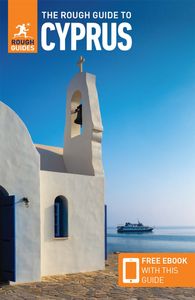
Find even more inspiration here

Planning your own trip? Prepare for your trip
Use Rough Guides' trusted partners for great rates

written by Andy Turner
updated 26.04.2021
Ready to travel and discover Cyprus?
Get support from our local experts for stress-free planning & worry-free travels.
- Where to stay
- Travel advice

Where to Stay on Cyprus: Ultimate Beach Resort Guide
Planning a trip to Cyprus? Here’s where to stay on this beautiful Mediterranean island. Town or beach? Lively or quiet? Glam or rustic? Apartment or hotel? Luxury or budget? This guide covers the popular Ayia Napa area, Paphos, and Larnaca – including the best beaches and the standout hotels in the area.
- which part of Cyprus to stay in
- where to stay in Nicosia , Paphos , Larnaca , Limassol, and Ayia Napa
- Cyprus’ main beach resort areas ; the best places to stay for nightlife and a younger crowd
- the best quiet resorts and villages on Cyprus ; the best places to stay for couples, families and nature
Shortlist – Best Places to Stay in Cyprus
- BEST LUXURY HOTELS : Amara , Anassa , Almyra ,
- BEST HOTELS HT ON THE BEACH : Anassa , Coral Beach Hotel & Resort , Nissi Beach Resort
- SWANKIEST VILLAS : Villa Adam , Kissonerga
- BEST INFINITY POOLS : Anassa , Hotel Napa Suites , Villa Paradiso
- BEST PLACES FOR FAMILIES : Protaras, Coral Bay
- BEST HOTELS FOR FAMILIES : Anassa , Amara , Capo Bay Hotel , Grecian Sands
- BEST FOR COUPLES : Almyra , Sunrise Jade Hotel , Cape Serenity Resort
- BEST CHIC RURAL ESCAPES : Apokryfo Hotel , Gillham Vineyard Hotel
- BEST BOUTIQUE TOWN HOTELS : Almyra , Polis 1907 , Alasia
- BEST PLACE FOR NIGHTLIFE : Ayia Napa, Limassol, Larnaca
- BEST QUIET BEACH RESORTS : Polis and Latchi
- BEST AREA FOR SANDY BEACH RESORTS : Ayia Napa, Protaras
- BEST AREA FOR EMPTY BEACHES : Karpas Peninsula

CYPRUS – A QUICK OVERVIEW
Cyprus is the third largest island in the Mediterranean, one of its newest nation states, and one of its most popular destination for beach holidays. Cyprus is the easternmost part of Europe and one of the hottest places in the Mediterranean . As such, the season is longer than other European destinations, with beach weather possible from April to the end of November.
Outside this time you will still find hotels open but bear in mind the pools and sea will be cold and the weather sometimes wet and windy. There’s a wealth of archaeological sites (with many temples dedicated to Aphrodite) and historic buildings around the island.
The Big Four resorts – Limassol , Paphos , Larnaca , and Ayia Napa – are coastal cities which draw international crowds and have an urban, cosmopolitan outlook and an abundance of large resort hotels. Prices are higher than you might expect – many items are not far off UK prices, except in north Cyprus which uses the Turkish Lira.
The coastline is very developed, with miles of high rise hotels and apartment blocks (and a woeful environmental record) as well as industrial areas and military bases. If you’re looking for the kind of charming harbour towns that are a dime a dozen in Greece then you won’t find them here, though Latchi is your closest approximation. Instead, look inland for charming villages and unspoilt landscapes.
The Republic of Cyprus is part of the EU and uses the Euro. From 1878 to 1914 the island was under British administration and is still a popular destination for tourists and expats from the UK.
What are the beaches like?
Although it’s a popular package holiday destination, fine white sand beaches are somewhat thin on the ground and focused around the Ayia Napa / Protaras area.
Sands on the rest of the south coast tend to be a dark golden or greyish colour with some grit. Much of the coastline is barren and rugged with incredible rock formations and dazzling turquoise waters – a boon for boat trip lovers, snorkellers and divers.
North Cyprus is much less developed and you’ll find some incredible untouched beaches here, particularly on the Karpas Peninsula, but don’t expect beachfront hotels. You’ll need a car and a sense of adventure to explore this area.

What’s the hotel scene like?
Package tourism and resort hotels are the name of the game Cyprus, though it’s also big with the second-home crowd so there are many vacation rentals on the market. Russians also visit Cyprus in large numbers and many of the big resort hotels cater to this demographic. The main resorts are also working cities with a year-round population (with the exception of Ayia Napa) and there are boutique rooms and business hotels available.
At the budget end, look for apart-hotels studios on the outskirts. Charming traditional guesthouses are easier to find inland, in mountain villages abundant with old stone buildings and frescoed monasteries.
Northern Cyprus
The Turkish Republic of Northern Cyprus is a self-declared Turkish-Cypriot state which occupies the northern third of the island and is recognised only by its sponsor Turkey. The island was divided in 1974 when the Turkish invaded following decades of inter-communal violence and a Greek coup d’etat . Thousands were displaced and lost land on each side.
The UN Buffer Zone (also known as the Green Line or the Attila Line ) is a demilitarised zone which bisects the island and also its capital city Nicosia. Restrictions on crossing the line were eased in 2003.
The north of Cyprus is beautiful place for the adventurous, with prices and infrastructure more similar to Turkey than the rest of Cyprus. The political situation has kept development at bay and its considerably more rustic than the south.
If you only intend on visiting north Cyprus then you can fly in to Ercan International Airport from Turkey (connecting flights are readily available). However if you wish to explore the whole island then you should fly in to Larnaca or Paphos.
Which Part of Cyprus To Choose?

- NORTH : Quieter, rustic and less developed, some fantastic wild beaches and historic sites but poor infrastructure. Lots of cheap casino hotels around Kyrenia and north of Famagusta.
- SOUTH EAST : This is where you’ll find some of the best beaches on the island as well as the party hotspot of Ayia Napa and the beautiful Capo Greco National Park. There’s a wide selection of hotels and resort areas.
- SOUTH : The big modern cities of Larnaca and Limassol dominate the busy south coast; it gets quieter as you go west towards Pissouri.
- WEST : The urban delights and archaeological sites of Paphos, with quieter coastline and turtle beaches around the pretty Akamas Peninsula.

Getting Around
Airports : Cyprus has two main international airports:
- Paphos International Airport (PFO)
- Larnaca International Airport (LCA)
They are both well served by European budget airlines – check Skyscanner for cheap fares.
Bus : The main cities and towns on Cyprus are well connected by intercity routes. During the summer season there are many routes connecting resort areas to the cities. Beyond this, it can be frustrating to travel by bus in Cyprus as local routes cater to school/work times. See Cyprus By Bus for more information.
Taxi : Taxis are generally expensive and drivers will often resist turning on the meter or attempt to overcharge. Transfers and shuttles are readily available to resort areas, and car rental is common.
Ferry : There are currently no ferry links between Cyprus and other international destinations although a future link with Greece has been given the green light.
Polis & Latchi

The northern shore of Cyprus is quiet and wild compared to the south, with few resort areas. The twin settlements of Polis and Latchi are located in Chrysochou Bay , just around the coast from the Akamas Peninsula. It’s no longer the hidden gem it once was – tour operators have invaded – but it’s is still popular with independent travellers. Polis is the larger town and Latchi is the closest thing Cyprus has to sleepy fishing village.
At the western end of Latchi is the beautiful Asprokremmos Beach. The luxury 5-star hotel Anassa occupies a prime beachfront location here. It’s an elegant yet laid-back complex featuring classical design that has been recently renovated, with an infinity pool overlooking the sea, and vies for the titles of best beach hotel in Cyprus. The location is tranquil and attracts couples and families looking for a luxe escape with entertainment for the kids. Also in the areas is the Caprice Spa Resort .
In town, the Polis 1907 is a good-value boutique 4-star with cool neutral decor in a renovated old stone building. On a budget? The Aphrodite Beach Hotel is a modern 2-star on Asprokremmos.
There are lots of villas both here and up the coast at Pomos , like the Villa Paradiso which has an incredible infinity pool.
Transfer time : 1 hour from Paphos airport.

Coral Bay is the first proper beach resort outside Paphos, with a wide Blue Flag beach of medium golden sand. It’s a 15-minute drive from Paphos and connected by regular buses throughout the season. It has a small commercial strip with a handful of lively eateries and bars.
The 5-star Coral Beach Hotel & Resort has a large tree-lined pool right by the waterfront and plenty of amenities.
Spacious 4-star Coral Thalassa Hotel is also by the sea, though a walk from the beach and strip.
Coral Bay is dominated by its two luxury hotels but you can also find villas (beautiful Villa Harmony sleeps 6 and has an infinity pool) and budget studios (try Petsas Apartments ).
Transfer time : 35 minutes from Paphos airport.

The coastal city of Paphos is the gateway to western Cyprus and is also one of its most enjoyable cities, with a slightly less brash feel than Larnaca or Limassol. It was a European Capital of Culture in 2017 and there’s a wide variety of things to see and do.
The main tourist area is called Kato Paphos . This harbourside area is where you’ll find the majority of tourist restaurants and shops, a small castle, as well as a few rocky platforms and small municipal beaches. A long promenade runs the length of the harbour and beyond. Keep walking west along the waterfront and you’ll eventually reach the huge Archaeological Park , a wave-battered coastline, and a prominent lighthouse. South of Kato Paphos you’ll find many big hotels and tourist entertainment like mini golf and a waterpark.
The old town area of the city is called Ktima and it’s situated 3km inland and uphill. Head here for cafes, local cuisine, the old Agora and Turkish quarter, and a few museums.
One of Paphos’ big draws is its vast UNESCO World Heritage-listed archaeological complex which spans two different sites and dates back to the 4th century BC. The Tomb of the Kings is part of the park but requires a separate entrance ticket.
Paphos Castle. Aphrodite Waterpark. Adonis Baths Waterfall. Pikni Forest. Scuba dives and boat trips. Plenty of international cuisine.
But the riches don’t stop in the city. The best beaches are to the north of Paphos, such as the protected Lara Beach with its turtle hatchery. The remote and beautiful Akamas Peninsula is a short drive away and is home to numerous nature trails, the Baths of Aphrodite , Adonis Baths , and the Avakas Gorge . South of Paphos is the famous Aphrodite’s Rock – and dramatic dark beaches with white cliffs.
With such a lot to see and do in the area, Paphos is a good choice for a cultural break year-round and it has a large ex-pat community.
Best 5-star hotels in Paphos:
- Chic hotels Almyra and Annabelle have a central location, impressive pools, and lively young crowd. Perfect city crash-pad for pleasure-seekers.
- Intercontinental Aphrodite Hills Resort Hotel is a vast luxury complex located south of Paphos near the village of Kouklia – with a golf course, sports facilities, villas and a hotel .
- Elysium is an upmarket resort hotel past the lighthouse and archaeological park
Best 4-star hotels in Paphos (lots of choice in this range):
- King Jason Paphos
- Alexander the Great
- Louis Paphos Breeze
- Louis Imperial Beach
- Aliathon Aegean
- Sofianna Resort & Spa
Best 3-star hotels in Paphos:
- Axiotheo Hotel is a traditional guesthouse up in Ktima with spectacular views.
- Dionysios Central is a huge centrally-located 3-star with shady courtyard and pool.
Trip Yard Hostel has dorms for backpackers.
Glamping fans should check out Yurts in Cyprus , located inland near the extensive Paphos Forest .
Transfer time : 20 minutes from Paphos International airport.

The beach resort of Pissouri is on the south coast, just past Aphrodite’s Rock but before you hit Limassol. It’s a small resort in an attractive location along 1km of sandy beach, with the main part of the village a short drive uphill. There is a small selection of cafes and restaurants by the beach, but you’ll find the majority of eateries and accommodation options up in the main villages.
There are many vineyards in the wider area. And if you feel the need for a day or a night out then Paphos and Limassol are both within half an hour.
Columbia Beach Resort is located down by the beach, as is Kotzias Beach Apartments .
Transfer time : 30 minutes from Paphos airport.

Limassol (officially called Lemesos ) is the second biggest city after capital Nicosia, and has the feel of an up-and-coming destination. It sits on the south coast, faceing south east in the Bay of Akrotiri.
The historic attractions here are Crusader and Ottoman rather than ancient ruins (though there are archaeological sites nearby at Amathous and Kourion ). It’s appealing old quarter is a highlight. Day trips into the Troodos mountains or the area’s many vineyards are another popular past-time.
But most people come for the buzz. It’s both a good-time resort city and a working town with a year-round population. The harbour area has had a ritzy revamp and attracts the megayacht crowd. Limassol is also the main cruise ship terminal on the island. It has a nightlife to rival Ayia Napa and is also an up-and coming foodie destinations.
Ladies’ Mile Beach runs south from the marina down to the military base that occupies the peninsula south of Limassol, and Akti Olympion beach runs northeast along the coast for several kilometres, backed by a promenade, a main road, and high rise buildings. The Blue Flag beach is a dark golden sand with some grit.
Limassol has a long season and is popular with Russians in the winter months. Avoid the stretch of coast between Limassol (past the Parklane Resort) and Larnaca which is depressingly seedy.
There’s a dazzling array of resort hotels along the waterfront, many are bookable as packages through TUI . Some are a long distance along the beach but there are regular buses that will sweep you downtown.
The top luxury 5-star hotels in Limassol are:
- Royal Apollonia
- St. Raphael Resort
- Four Seasons Hotel
- Amathus Beach Hotel
- Parklane Resort
The best 4-star hotels are:
- Atlantica Miramare Beach
- Londa Hotel
- Mediterranean Beach Hotel
For boutique town rooms try Alasia or the S Paul City Hotel .
On a backpacker budget? There are dorms at Lima Sol House and Lemongrass .
Looking for something unique and Instagrammable? Quirky Euphoria Art Land has colourful dome houses covered in mosaics.
Transfer time : 50 minutes from both Larnaca and Paphos airports.

Larnaca (or Larnaka, as you will sometimes see it spelt) is home to an international airport and is the gateway to the east of the island.
As with the other coastal cities on the island, Larnaca has a small historic centre which contains a buzzing harbour area and promenade, a modern marina, old mosques, an archaeological museum, Byzantine churches, a medieval fort, and pleasant backstreets.
The urban spreads out along the coastline and as with Limassol, the sand is a slightly drab dark gold colour – though wide and with plenty of amenities and beach hotels. But if you find yourself craving a better beach then it’s easy enough to visit Ayia Napa for the day.
Don’t miss a visit to beautiful mosque of Hala Sultan Tekke which is set in flamingo-inhabited salt flats.
South of Larnaca – past the airport – is Perivolia , a small and still relatively traditional beach resort area. The beach here is quieter and windier (surfing and kitesurfing is possible) and you can pick up some bargains on Booking.com .
The top luxury resort hotels in Larnaca are:
- Radisson Blu Hotel
- Golden Bay Beach Hotel
- Palm Beach Hotel and Bungalows .
For stylish rooms in town check out:
- Ciao Stelio Deluxe Hotel (Adults only)
- Josephine Boutique Hotel
- Hotel Indigo (Adults only)
Wooden camping bungalows are available at Cyprus Glamping Park.
Transfer time : 15 minutes from Larnaca airport.

Cyprus’ premier beach resort, Ayia Napa has been a package tourism stronghold since the 1970s. It’s the party town of Cyprus and its hedonistic nightlife is the stuff of legends. Its notoriety peaked around millennium. Although it has calmed down a lot since then, it still attracts young groups and you can party dawn-to-dusk at the square, on boats, and at pool parties and beach clubs.
Those just looking for a self contained beach break will find a selection of tempting white sands beaches.
Ayia Napa is a large modern town which sits on the south side of a peninsula at the eastern end of Cyprus. Boat trips are available around the Capo Greco National Park with its steep cliffs and turquoise waters.
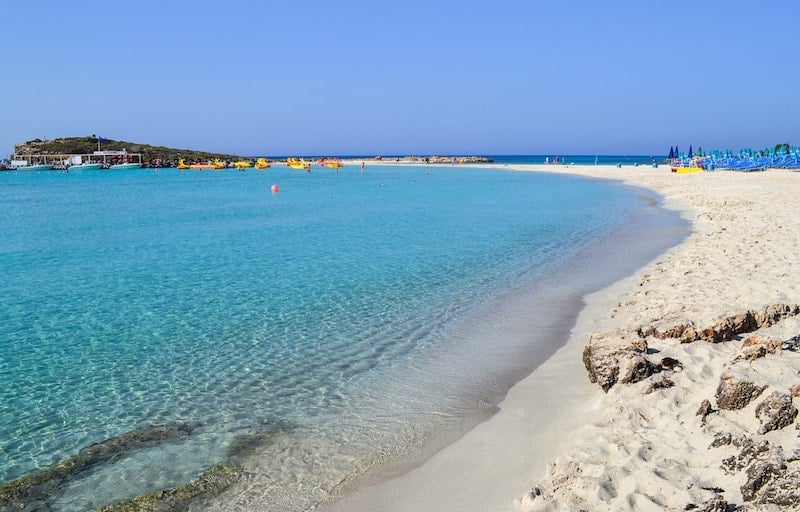
Of the big 4 resorts, Ayia Napa is more resort town than Cypriot city. There are more self-contained all-inclusive resort hotels here, and little else to do but sunbathe, eat, drink, sleep, shop, and party (though there is a waterpark for the kids). Tourism is seasonal and it closes down in the winter.
The main town beach is Pantachou which is long and sandy and lined with beach bars. West of here is a series of sandy beaches – you can cycle, walk, or catch a bus along the coast. The most beautiful is undoubtedly Nissi Beach (pictured above), 2km west of town. Here you’ll find shallow turquoise lagoon waters and powder-soft sands that connect a small island to the shore. It’s also crazy popular, especially in the summer when it hosts beach parties. West of Nissi there are fine beaches at Landa and Makronissos .

For 5-star luxury, the best hotels in Ayia Napa are:
- NissiBlu Beach Resort
- Chrysomare Beach Hotel & Resort
- Adams Beach Hotel Deluxe Wing (Adults-only, Nissi Beach)
Beachfront 4-star hotels include:
- Okeanos Beach Boutique Hotel
- Nissi Beach Resort
And for stylish town rooms check out:
- Hotel Napa Suites (incredible infinity pool)
Backpackers can head to the House of Nissus Hostel for dorm beds and BBQs.
Transfer time : 40 minutes from Larnaca airport.
Protaras (Fig Tree Bay)

The popular resort area of Protaras (also known as Fig Tree Bay) is over on the north side of the peninsula, a short distance from Ayia Napa. Some of the nicest organised beaches on the island are around here. The name encompasses a long stretch of shore with several beaches – Sunrise , Fig Tree , Pernera , Sirena , Konnos Beach .
The main part of Protaras is a series of large self-contained hotels with landscape gardens leading to a narrow sandy beach. The northern end of Protaras blends into the quieter village of Pernera , and then to the larger workaday conurbation of Paralimni . The beaches here become smaller and more local. The southern end towards Konnos Beach is very pretty and you have the benefit of being close to the Capo Greco National Forest Park for walks.
Many of the hotels in Protaras are all-inclusive but you will find restaurants, rentals, and other facilities along the main strip which runs parallel to the beach, and also at Pernera. It’s a 20-minute drive to Ayia Napa.
If you’re not all in for the vibes of Ayia Napa then this is a good alternative – it’s a bit more relaxed and more family friendly, attracting a mixed crowd (and a lot of Scandinavians).
The best hotel around is the 5-star Sunrise Jade Hotel (Adults only). Pick of the 4-stars is the Sunprime Protaras Beach (Adults only).
Kids in tow? Try the Capo Bay Hotel .
The Artisan Resort is a complex of beachfront villas near Konnos Bay, or for resort hotels look at Grecian Park Hotel and Cape Serenity Resort (Adults-only) .
Transfer time : 1 hour from Larnaca airport.

Nicosia is the divided capital of Cyprus and it sits squarely in the centre of the island. It’s less touristy than the coastal cities, but if you don’t mind being inland then it’s a good base for exploring the island, given its central location and good roads that fan out in every direction. You may also wish to stop here and explore en route to north Cyprus.
On the plus side, Nicosia is two cities in one – it’s culturally rich and the best place to learn about local history, politics, culture, and cuisine. Fans of archaeology and urban grit will appreciate the city.
The old town is encircled by crumbling Venetian walls and ‘the Green Line’ runs straight through it, dividing the city in two. Each half has a distinct feel – the south more modern and more commercial, the north sleepier with some interesting Gothic and Ottoman architecture. Highlights include the Cyprus Museum (one of many archaological museums), and Büyük Han caravanserei (pictured below). There’s also a burgeoning cafe and bar scene, particularly around Famagusta Gate, traditional hamams, and a forest park.

Downsides are that the tourist infrastructure is not great and the political problems are on stark display. There’s endless urban sprawl and much of the old town is in a bad state.
You can cross the border by foot (at least in normal times) – bring your passport. Nicosia is the kind of place that benefits from a walking tour and the municipality runs free tours on both sides of the line.
Nicosia (the ‘Greek’ bit)
Accommodation in the city is geared towards business travel and and visiting dignitaries, so there are a few high end hotel worth checking out:
- The Landmark Nicosia
- Hilton Nicosia
You can also find good value in the mid-range hotels:
- Cleopatra Hotel
- MAP Boutique Hotel
- Almond Business Hotel
- 3 Rooms Boutique Hotel
Decent budget options are hard to come by though. There are a few hostels such as Nex but reviews are mixed and prices on the high side.
Airbnb can yield some gems such as this beautiful loft renovation .
North Nicosia (the ‘Turkish’ bit)
Generally the north Nicosia (the Turkish bit) is cheaper and you can also find some quirky boutique hotels in the old quarter such as:
- Hotel Valide Hanim Konak
- Nicosia Eagle Eye
- Cypriot Swallow Boutique Hotel
- Gul Hanim House Boutique Hotel

Although North Cyprus has less tourism than the south, it’s all centred around the seaside town of Kyrenia . And it’s easy to see why – Kyrenia has a well-preserved medieval quarter surrounding its horseshoe-shaped harbour. Its well-loved by Brits and has a large ex-pat community, many of whom reside in pretty villages that dot the hillsides.
Up in the hills behind is the photogenic St. Hilarion Castle , carved into limestone crags, and the romantic Bellapais Abbey . Wildfires in 1995 caused substantial damage to the local flora but it’s still a fantastic area for walking, being greener and hillier than the south coast.
Most of the big resort hotels are located on the coast and tend to be huge and gaudy Vegas-style affairs with in-house casinos. Best of the bunch are:
- Rocks Hotel & Casino
- Lords Palace Hotel SPA & Casino
For something a little less splashy, Kyrenia Palace Boutique Hotel has cosy rooms in a renovated historic building. And if you want to be right on the harbour then Nostalgia has quaint rooms in a traditional building. There are more charming guesthouses and hotels are found in up the hills though, such as Bellapais Gardens Hotel and Kenerli Konak .
Plenty of options on the budget end – Meryem’s Hotel is good value and has a pool. There are many apartments and villas in the area on Booking.com .
Transfer time : 40 minutes from Ercan airport.
Karpas Peninsula

The long spindly bit of land at the far east of north Cyprus is the Karpas Peninsula .. This is one of the most beautiful and unspoilt parts of Cyprus, if not the whole Mediterranean. The beaches here are vast, sandy, and largely empty. You’ll need a car to explore it.
There isn’t an abundance of hotels, which is part of its charm. But there is a small cluster at Risokarpaso such as Oasis at Ayfilon and the Glaro Garden Hotel .
Try VRBO for vacation rentals in the area.
Abandoned since the invasion of 1974, the resort of Famagusta was once one of the most popular destinations Cyprus, attracting a ritzy glamorous set. Occupying a prime position in Salamis Bay, Famagusta is surrounded by amazing sandy beaches. Tourism was centred around the beach at Varosha which was lined with high-rises and grand hotels.
The Greek-Cypriot population fled after invading Turks bombed the city (which also caused heavy damage to its historic quarter), and then were prevented from returning when the island was partitioned. A 1984 UN resolution decreed that the city could not be resettled. Now it’s a ghost town and nature is reclaiming the city. Famagusta is still a flashpoint in local politics. You can visit on organised tours from neighbouring resort areas but be aware that you can’t enter Varosha which is fenced off. It’s possible to stay in the northern part of town.
North of Famagusta and the ancient ruins at Salamis there is a stretch of coast up to Boğaz which is home to vast cut-price (though slightly depressing) resort hotels.
10 Most Beautiful Beaches in Cyprus
Where to Stay on Mallorca: Ultimate Beach Resort Guide
Where to Stay on Ibiza: Ultimate Beach Resort Guide
Where to Stay on Menorca: Ultimate Beach Resort Guide
Where to Stay on Sicily: Ultimate Beach Resort Guide
Where to Stay on Sardinia: Ultimate Beach Resort Guide
Where to Stay on Corsica: Ultimate Beach Resort Guide
Where to Stay on Malta: Ultimate Beach Resort Guide
Where to Stay on Crete: Ultimate Beach Resort Guide
Where to Stay on Corfu: Ultimate Beach Resort Guide
Where to Stay on Kefalonia: Ultimate Beach Resort Guide
Where to Stay on Lefkada: Ultimate Beach Resort Guide
Where to Stay on Zakynthos: Ultimate Beach Resort Guide
Where to Stay on Skiathos: Ultimate Beach Resort Guide
Where to Stay on Kos: Ultimate Beach Resort Guide
Where to Stay on Rhodes: Ultimate Beach Resort Guide
Where to Stay in Halkidiki: Ultimate Beach Resort Guide
Where to Stay on the Turkish Coast: Ultimate Beach Resort Guide
Enjoyed this post? Follow us on Facebook or Twitter .
Click to save to Pinterest:

Image credits:
Aerial view of Ayia Napa beach: © Valentinos Loucaides / Adobe Stock
Rocky coastline of Capo Greco: © zinaidasopina112 / Adobe Stock
Rock of Aphrodite: © pkazmierczak/ Adobe Stock
Limassol old town: © kirill_makarov/ Adobe Stock
Cyprus resort map: © The Mediterranean Traveller
Hala Sultan Tekke: © Evgeni/ Adobe Stock
Latchi harbour: © efesenko/ Adobe Stock
Coral Bay: © pixtour/ Adobe Stock
Paphos Cathedral: © ais60 / Adobe Stock
Pissouri: © Grispb/ Adobe Stock
Limassol marina: © f8grapher / Adobe Stock
Larnaca coastline: © ais60 / Adobe Stock
Ayia Napa aerial: © diy13/ Adobe Stock
Nissi Beach: © Aleksandr / Adobe Stock
Makronissos Beach: © Tupungato/ Adobe Stock
Nicosia skyline: © Klemen Misic/ Adobe Stock
Buyuk Han in Nicosia: © ingusk / Adobe Stock
Kyrenia harbour: © vladislav333222 / Adobe Stock

Share this post:
The best things to do in Cyprus: sun, sand and ancient civilizations

Nov 17, 2021 • 7 min read

Cyprus is beaches, walking, history and more © wundervisuals / Getty Images
Cyprus is a small island with a huge amount of fabulous things to do. The appeal includes several millennia of history — including some of the most incredible ancient sites in the Mediterranean – spectacular beaches, bounteous platters of superb food and much, much more.
The island's bifurcated cultures uneasily coexist yet they’re unified by a welcoming tradition of hospitality that will have you looking for ways to delay your departure. It's easy to visit both the Greek Republic of Cyprus and the Turkish Republic of Northern Cyprus via the seven border crossings linking the two halves of the island.
Travelers from many countries can visit both north and south without a visa , opening up a fascinating journey through both Greek and Turkish culture. Here are the best things to do in Cyprus.
Cross the line
The UN-administered Green Line has split Cyprus in two since 1974. Most people head for the Republic in the south, ignoring the comparatively less-visited Turkish Republic of Northern Cyprus, with its natural beauty, ancient ruins, rich culture and Turkish accent.
Among the unmissable surprises in the North, make time for historic Famagusta (Gazimağusa) , which hides Gothic beauty behind its Venetian-era walls, and the Karpas Peninsula, with its wild beaches stalked by wilder donkeys. If time is short, hop over the border on foot to explore North Nicosia (Lefkoşa) , where each twisted alley leads to another architectural treasure.
Find the perfect Mediterranean package in Pafos
Is Pafos the best all-around city in Cyprus? That's for you to decide, but we love its beguiling seafront strip of excellent cafes and beaches, and its backstreets lined with medieval buildings and mysterious chapels. For many, the top sight is the collection of Roman mosaics in Pafos' sprawling shorefront archeological site , but make time for the colonial district with its excellent museums, and the brilliant diving offshore. Maximize your time for fun and fly into Pafos’ international airport, saving yourself a drive from Larnaka — you’re going to need every spare minute in Pafos.
Discover Cyprus' national parks
The national parks of Cyprus cater to every taste, from family-friendly expanses perfect for picnics – complete with playgrounds and mountain views – to vast, remote retreats in the hills. Reserves such as Cape Greco National Forest Park and Troödos National Forest Park do a great job of preserving the island’s natural beauty; come to stretch your legs and explore pine forests, wildflower-blanketed meadows, craggy limestone cliffs, isolated beach and even snowy peaks. You can swim and ski all in one day!
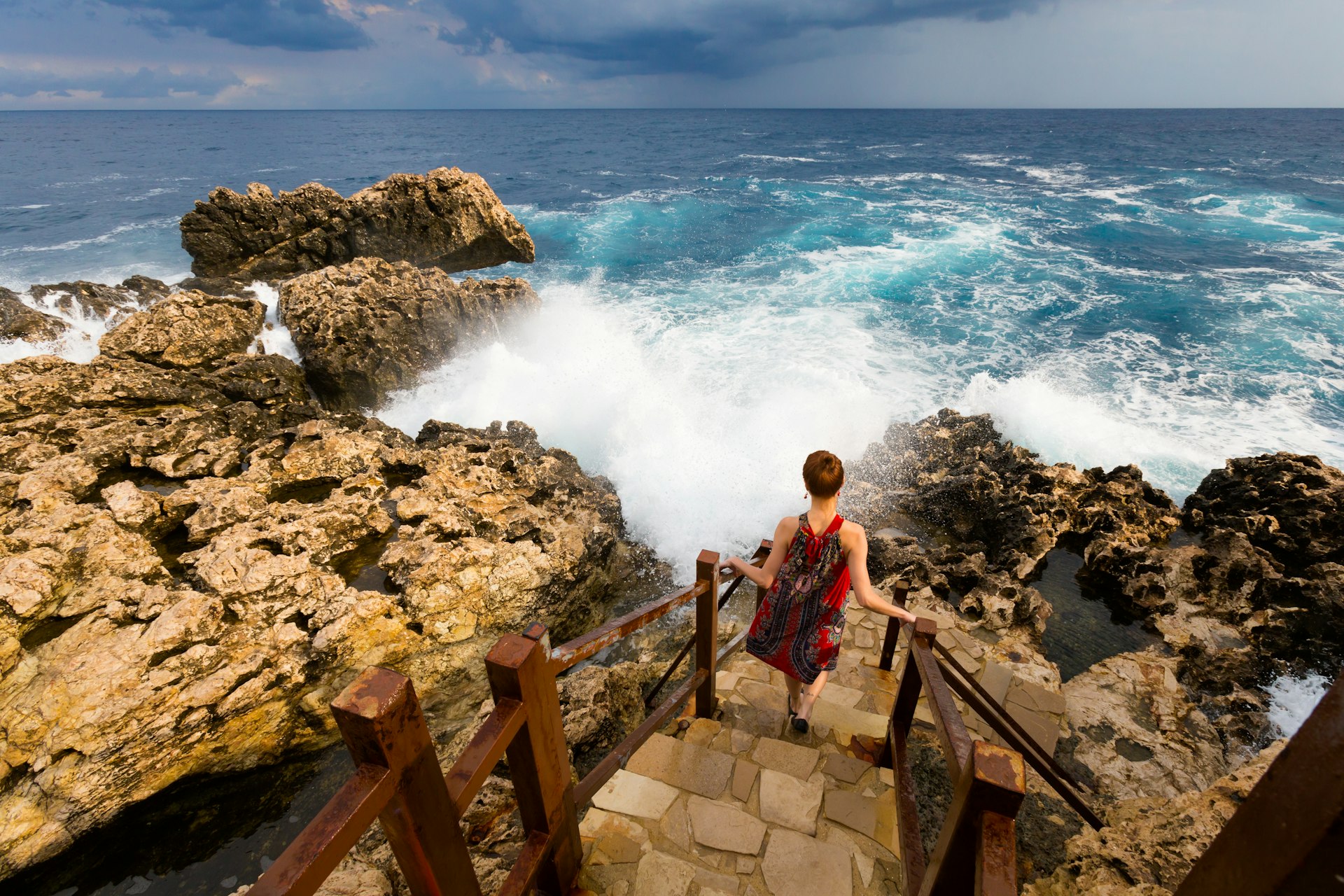
Feast on more meze dishes than you can count
Meze is short for mezedes (“little delicacies”), a Cypriot food tradition that’s as much Turkish as it is Greek. And there's no better way to unify the island’s cultures than through a seemingly ceaseless cavalcade of small plates of Cyprus delicacies, hot and cold, savory and sweet, freshly made and preserved.
Get a group together and don’t stop the culinary assault until you’re at least 10 dishes past the point you lost count. Best of all, there’re plenty of excellent local wines to lubricate the feast. Start the sampling at Zanettos Taverna in Nicosia (Lefkosia), which has been cooking up a storm since 1938.
Dive the Zenobia
Considered one of the very best wreck dives in the world, the Zenobia was a Swedish-built freighter that went down off Larnaka in 1980. Today, a jumbled cargo of trucks spills out of its broken holds like an aquatic scrapyard. Local dive operators arrange trips for people of all skill levels. You can explore the decks of the ship and revel in the teaming marine life attracted to this unplanned artificial reef.
Tour the Byzantine churches of the Troödos
“Bright” doesn’t suffice to describe the colors splashed over the interior walls and ceilings of these outwardly unremarkable-looking churches dropped into clefts in the Troödos Mountains. From the 11th to the 16th centuries, countless artisans transformed the interiors of these stone chapels into works of art that are rightfully listed as Unesco World Heritage sites. Once you enter Panagia Forviotissa chapel – or any of the other late- and post-Byzantine chapels nearby – give yourself extra time to savor the vibrant details.
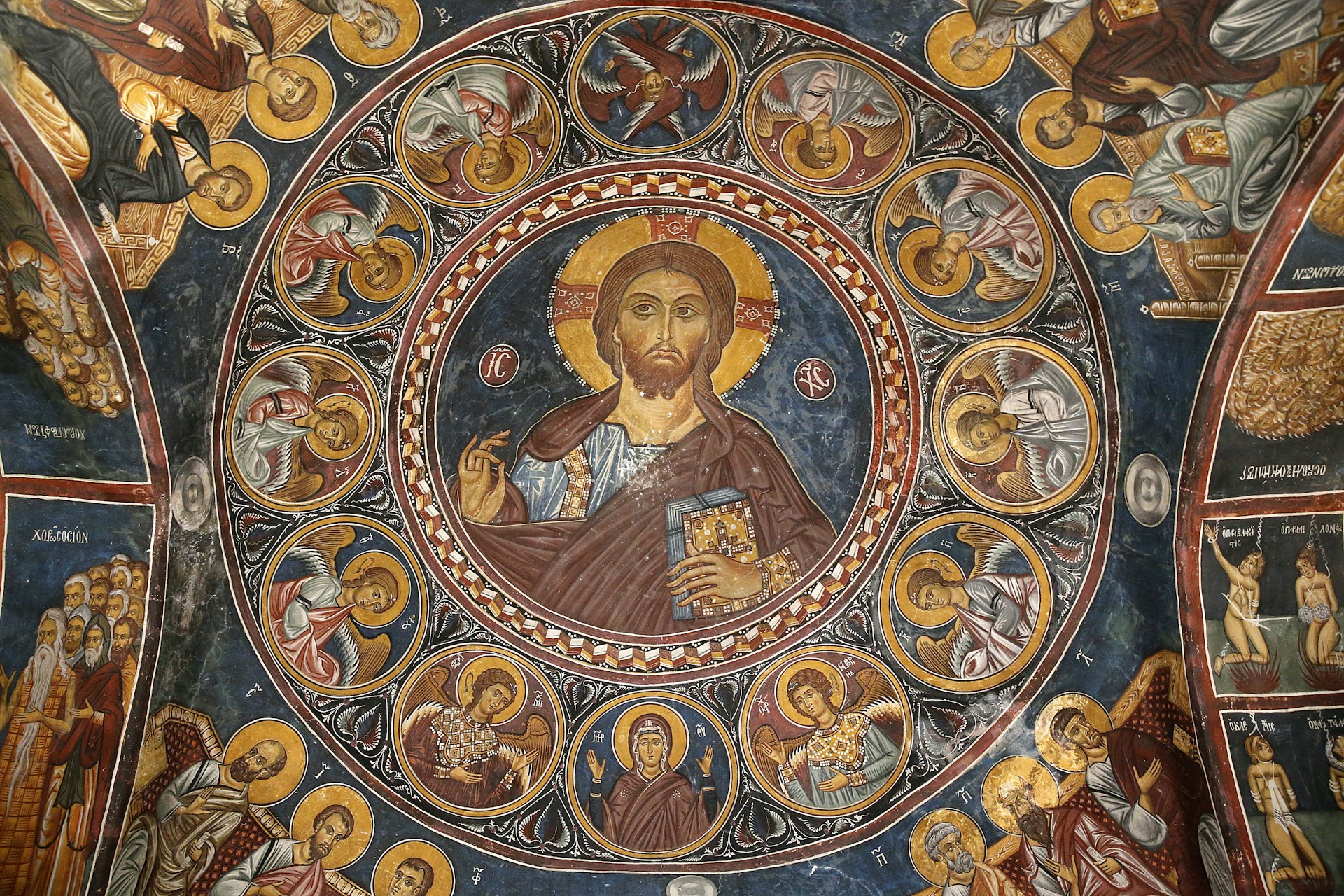
Have a therapeutic pounding at Büyük Hamam
In the medieval Iplik Bazar–Korkut Effendi quarter of North Nicosia, look for the tiny ornate door set 2m below street level that leads to this traditional Turkish bathhouse . Originally part of the 14th-century Church of St George of the Latins, this cultural relic provides the full soak-and-scrub experience, from a rough exfoliation with black soap to a pounding massage. For the complete treatment, come during the early evening most days when “touristic services” are offered.

Find solace in the Sanctuary of Aphrodite
Cyprus is packed with sites related to the ancient Greek goddess of love, passion and plenty of other pleasures. Yet somehow, one of the most significant places linked to the island’s patron goddess is also one of the least visited. Credit to Unesco for making these handsome Greek and Roman ruins a World Heritage Site. An interesting museum gives context for the treasures while walkways around the site have splendid seashore views.
Stroll around Kyrenia’s historic harbor
A cauldron of history, the old harbor in the heart of Kyrenia (Girne) has a little bit of history from every era, including a looming castle with relics from the Romans, Ottomans, even Richard the Lionheart. Toss in the disheveled remains of a 16th-century church, a centuries-old mosque, abandoned stone warehouses subsiding into oblivion plus the inevitable Greek and Roman ruins and you have a heady — and unrestored — mix of the island’s legacies.
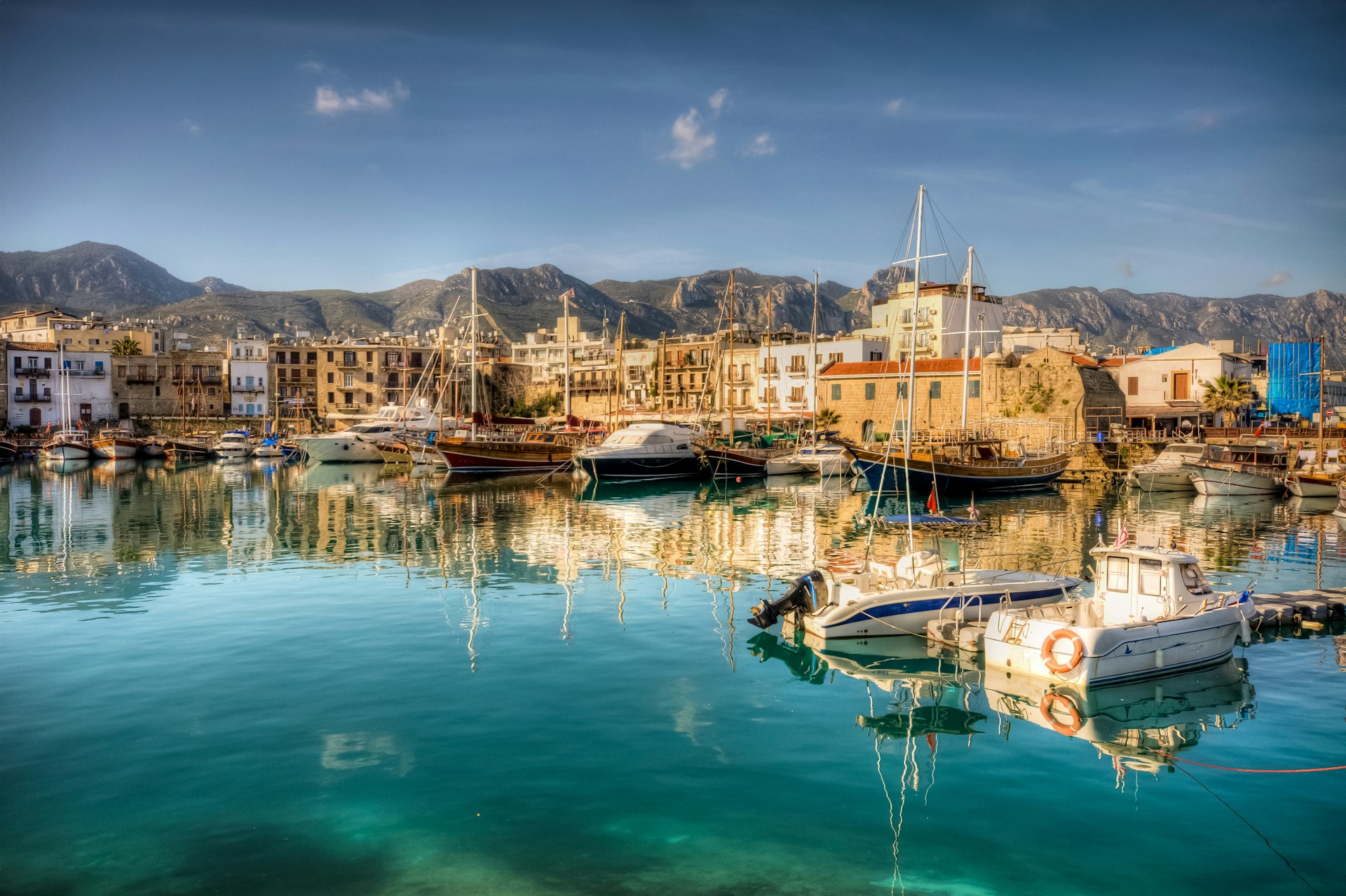
Join the coffee debate
Turkish coffee or Greek coffee? Debating the differences between these two cups – both central to the cultures of their respective portions of Cyprus – may divide more than it unites, but lucky you getting to do the research to form your own conclusion. Compare these strong little cups brewed from finely ground beans in the stylish cafes of Nicosia (Lefkosia) and the humbler backstreet stalls in North Nicosia (Lefkoşa).
Marvel at the mosaics at Pafos Archaeological Site
The archeologists have their work cut out for them at the sprawling Pafos Archaeological Site , given that all the magnificence on display is but a fraction of what is thought to still be under the ground, waiting to be uncovered. The Romans loved their mosaics, and the examples in this ancient city from the 4th century BCE are superb even by their high standards. Wander amidst reconstructed arches, outcroppings of wild sage and impossibly huge blocks of marble and let loose with your inner toga.
Party on the beach
Protaras at the east end of the Republic is the anchor for a string of beaches that erupt with joyful crowds and pleasure all summer long. Here you don’t decry the mobs, you join them for fun, both in and out of the water, all day and all night long. One of the best options here, Fig Tree Bay has a small sand island just offshore and a staggering assortment of clubs, bars, watersports rental shacks and much more inland.

Windsurf Cyprus' wind-buffed coves
Windsurfers of all skill levels can find ideal conditions at some point along the island’s filigreed coast. Beginners can take lessons and learn the ropes in the sheltered waters of Pissouri Bay, between Lemesos (Limassol) and Pafos on the southwest coast. Those who’ve mastered their boards can battle the blows at world-class sites like Lady’s Mile Beach on the Akrotiri Peninsula.
Get lost in Ancient Salamis
Littered with the detritus of great civilizations from the ancient Greeks to the Byzantine empire, with Assyrians, Romans and a few others in between, the grand archaeological site of Ancient Salamis is one of the glories of Cyprus. Stake out a seat in the large amphitheater and ponder the passing of one of the ancient world’s great city-states, then lose yourself on the paths that wander through these spectacular seaside ruins.
Wander Cyprus' wine-tasting villages
The sun-drenched, south-facing slopes of the Omodos region form the heartland of Cypriot wine culture. Grapes have been grown here for centuries and every farmhouse is said to have old wine-making tools in its cellar (check out the collection at Socrates Traditional House ). Today, more than 50 wineries operate in these tiny hillside villages and the region is known for its bold Shirazes and cabernets as well as some pleasing dry whites. Touring and tasting in these splendid surroundings makes for a fine afternoon.
You may also like: The best places to visit in Cyprus: from Aphrodite's rock to Adonis' bath See a different side to Cyprus on these stunning hikes The 8 most beautiful beaches in Cyprus for wildlife, swimming, and partying
Explore related stories
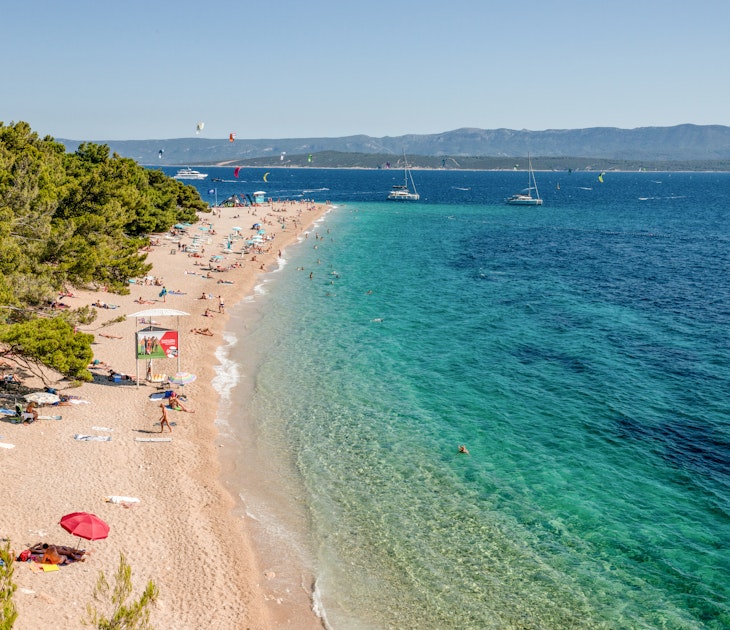
Feb 26, 2024 • 8 min read
From the wind-lashed shores of the Atlantic coast to the secluded coves of Italy, here are Europe's very best beaches.

Oct 25, 2023 • 7 min read
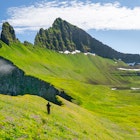
Dec 6, 2022 • 10 min read
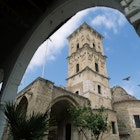
Jan 13, 2022 • 8 min read

Nov 17, 2021 • 6 min read
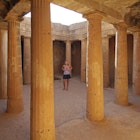
Nov 5, 2021 • 6 min read

Nov 4, 2021 • 4 min read
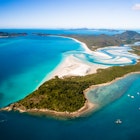
Jul 1, 2019 • 5 min read

16 Top-Rated Attractions & Places to Visit in Cyprus
Written by Jess Lee Updated Mar 22, 2022
This island has a grand history. Coveted by empires across the centuries, Cyprus' enviable position has made it a prized possession for all who rose to power in the Eastern Mediterranean.
Today, people still flock here, but it's now to seek out the island's beaches rather than to gain power and glory.
For travelers interested in more than sand and sun, you're in for a treat, as Cyprus has archaeological sites , fine Byzantine churches, and monasteries and museums galore among its historic tourist attractions.
It's also a wonderful place to go hiking , with an incredible wealth of unique flora and fauna. Best of all, it's so small that you can easily base yourself in one town and head out on sightseeing day trips from there.
Make sure you don't miss any of what's on offer by using our list of the top attractions and places to visit in Cyprus.
1. Ancient Kourion
2. st. hilarion castle, 4. karpas peninsula, 5. ancient salamis, 6. kolossi castle, 7. cape greco, 8. troodos villages, 9. house of dionysus, 10. cyprus museum, 11. nissi beach, 12. kyrenia, 13. underwater museum, 14. famagusta old city, 15. protaras beaches, 16. nicosia old city.
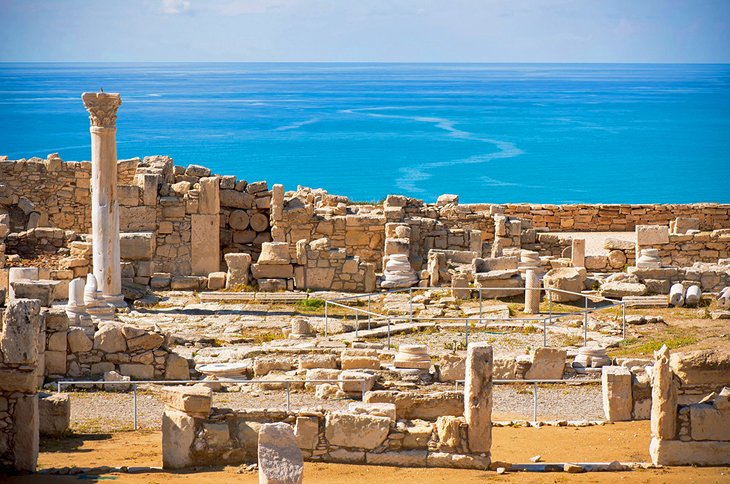
There's no shortage of ancient sites in Cyprus, but Kourion is the pick of the bunch. Exploring the grand monuments and mosaics here is one of the best things to do in Cyprus .
Romantically situated across a coastal cliff, with tumbling views of the countryside and Mediterranean below, it's a magical place.
The entire site is vast, but the most famous places to visit while here are the theater and the House of Eustolios , which holds a clutch of fine, well-preserved mosaics.
For those with more time up their sleeves, the large Byzantine basilica area is wonderfully picturesque with its tumbled columns and scraps of mosaic floor.
- Read More: Top-Rated Tourist Attractions in Limassol
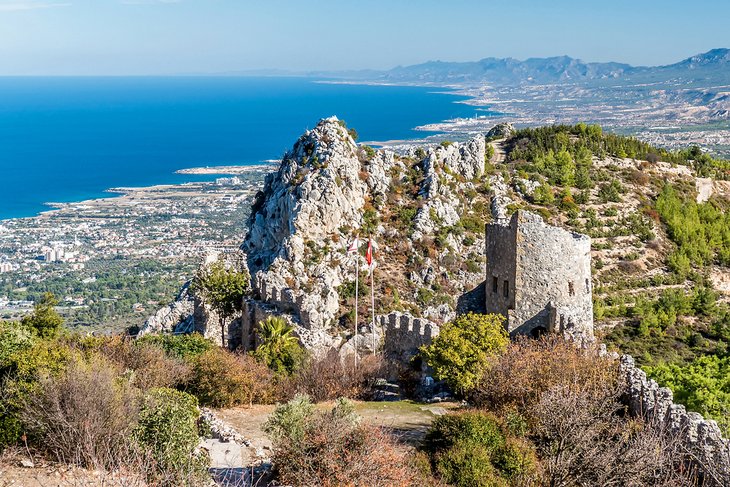
One of the Mediterranean's most beautiful castle ruins, St. Hilarion is an old Crusader bastion and home to many myths and legends.
Local lore claims the castle itself was built by a fairy queen, who used to charm local shepherds on the slopes here.
The castle's extensive ramparts and chambers snake up the mountain and are explorer heaven. A trail runs through the lower castle buildings of soldier barracks and stables, up to the remnants of towers, royal apartments, and chapels.
For those that climb right to the top, the views across the hills and down to the coastal plain are phenomenal.
St. Hilarion is in north Cyprus, so you need to cross the Green Line to visit. The north has three major castle ruins, but St. Hilarion is by far the best preserved. This is the one to visit if you're only on a day trip to the north.
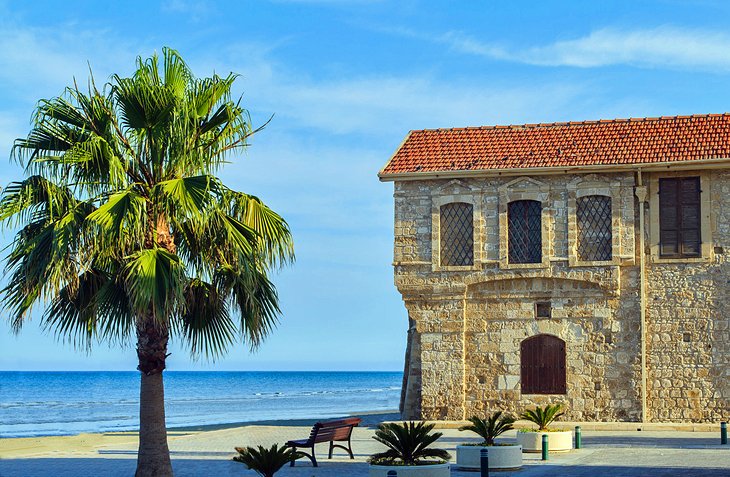
Easygoing Larnaca, on the island's southeast coast, may be a seaside resort, but it's kept its local soul.
This is by far the most laid-back base for holidaymakers here. All the facilities for sun- and sand-based fun can be found, but the old crumbling Turkish Quarter (called Skala) and ornate Agios Lazaros (Church of St. Lazarus) give the town an interesting historical edge, while the center itself has retained the atmosphere of a proper workaday town rather than just a summer resort.
Even better, the salt lake , just to Larnaca's west, is packed full of flocks of pink flamingos during spring, and plenty of hill villages and cultural tourist attractions lie in the surrounding hinterland.
- Read More: Top-Rated Tourist Attractions in Larnaca
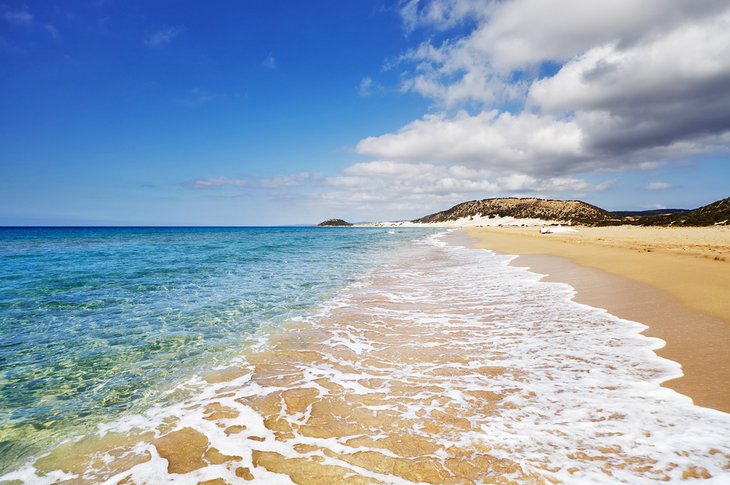
The most beautiful region in Cyprus is the lonely and rugged Karpas Peninsula, which stretches out in a long finger of golden beaches backed by rugged hills in the northeast of the island (in north Cyprus).
It's Cyprus' least trodden area with sublime hiking, quaint villages, and hidden historical sites in abundance.
This is the place you need to head if you want to experience the undiscovered and undeveloped island life of old.
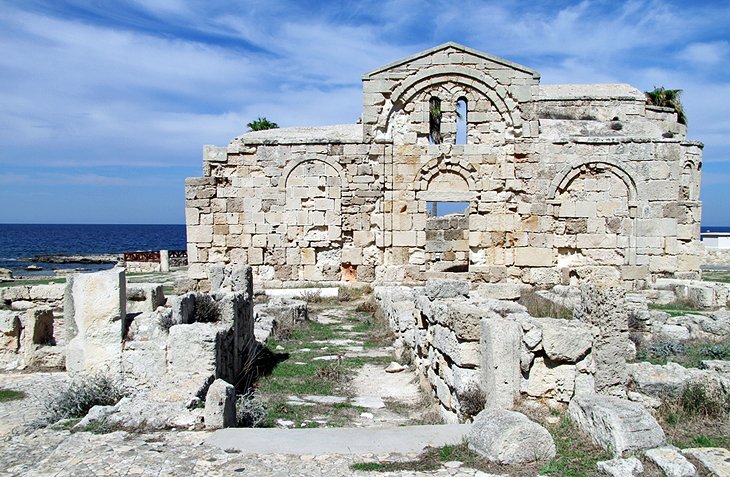
Venture out for the day in a car (the area has virtually no public transport) and visit the mosaics of Agia Triada at Sipahi village before heading further northeast to remote Dipkarpaz village and the small ruin of Agios Filon church.
Afterwards, move on to the peninsula's famous Golden Beach, a vast swath of sand that sums up the Karpas' rugged appeal.
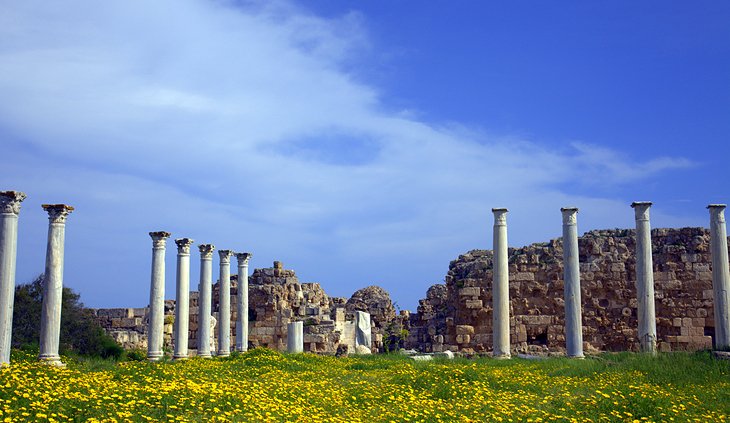
This huge archaeological site is home to a wealth of marble ruins and ranks up there with Ancient Kourion as the top historical site on the island.
Wandering along the dirt tracks of Salamis between sets of ruins from a muddle of different time periods is a lesson in the vast history of Cyprus.
Grand Hellenistic statuary – missing their heads, which were lopped off by over-zealous Christians – sit amid the ruins of the Gymnasium.
Two substantial ruins of Byzantine churches stand amid fields of wild fennel and weeds, and a humongous reservoir area showcases the engineering ability and management of what must have once been a grand ancient city.
Ancient Salamis is in north Cyprus and is easily combined with a day trip to Famagusta.
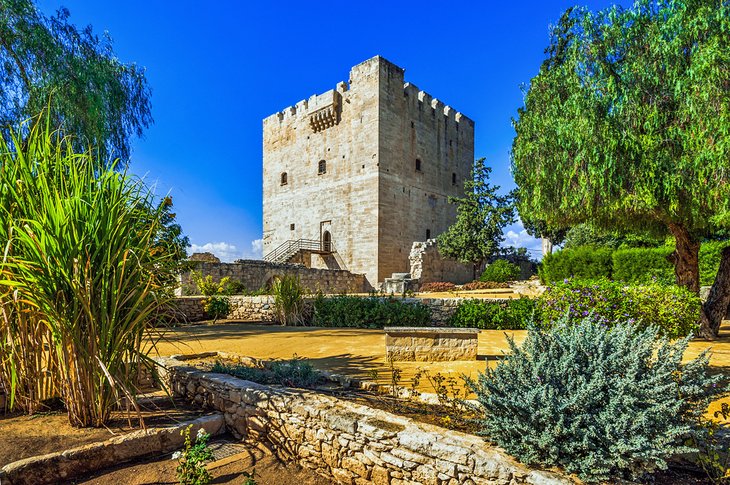
If castles had cuteness competitions, Kolossi would surely come up trumps. This tiny but perfectly formed castle just outside of Limassol is an old Crusader stronghold and a reminder of Cyprus' importance for the Europeans during the Holy Land Crusades.
First held by the Knights of St. John, the castle was used as a commandery for the area, with an excellent location looking out over the coast line.
Today, the castle's appeal is mostly down to its dollhouse proportions and its tranquil position amid snoozy Kolossi village.
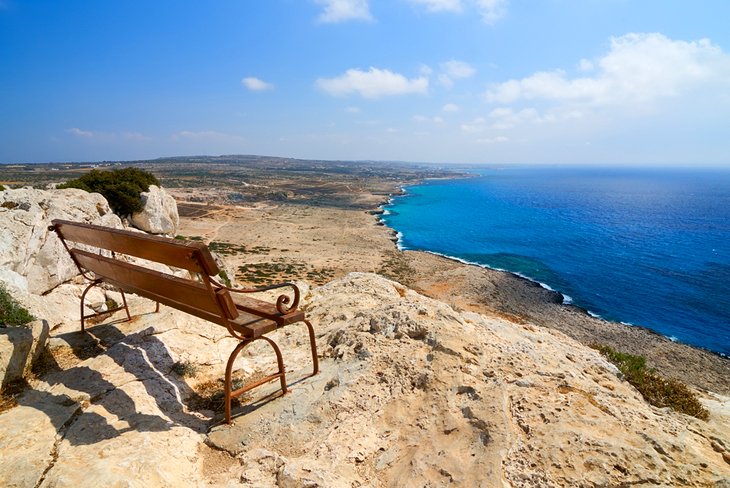
Even along Cyprus' buzzing south coast, there are regions where you can escape the crowds.
Cape Greco is a rugged and rocky coastal national park covering the promontory that makes up the island's southerly tip. There's a variety of walking trails here that start just east of the resort of Agia Napa.
The longest trail winds across the rocky headland, with staircases at points along the cliff, where you can descend to swim by the sea caves, and ending at the tiny cove of Konnos Beach, where you can cool off with another swim after your walk.
There is a wonderful variety of local flora here, particularly many of Cyprus' endemic wild orchids that bloom in early spring but the real highlight is the absolutely gorgeous coastal scenery with azure blue sea beyond.
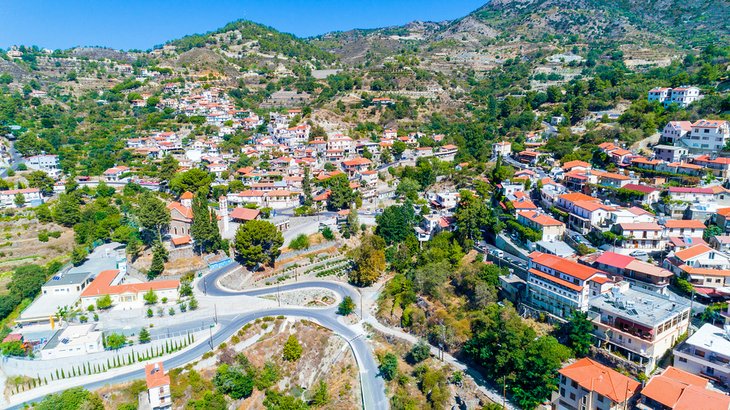
The Troodos Massif (Troodos Mountains), in the hill region of the southwest, are packed full of pretty villages full of stone-cut traditional houses and cobblestone alleys.
They're also home to some of Cyprus' most amazing churches and monasteries that hold vibrant frescoes and wall paintings that date from the medieval era.
The Troodos churches are so important historically that nine of them have been given UNESCO World Heritage status.
Hiring a car and tootling around this area, searching out stone cut chapels is a great day out but if you only have time to view one, the Church of Archangelos Michail in the little village of Pedoulas should be top of your things to do list.
For self-drive day trip potential, the Troodos Mountains are easiest accessed using Limassol or Nicosia as your base.
To cut down on the driving there are also plenty of small boutique-style hotels in the main Troodos Mountains villages themselves.
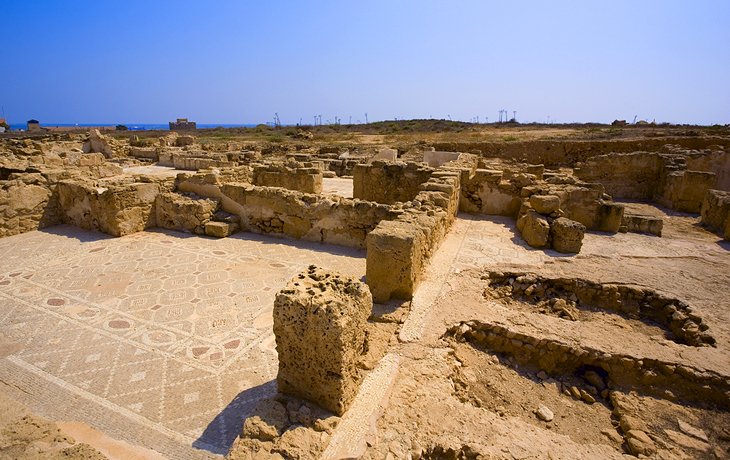
The big-hitter site in the resort of Paphos is the House of Dionysus, home to an incredible collection of mosaic floors that are feted for their excellent preservation and vibrant coloring.
Part of the larger Paphos Archaeological Site which contains the excavated remains of ancient Paphos, the area is home to a variety of Greco-Roman ruins, as well as several other mosaic houses.
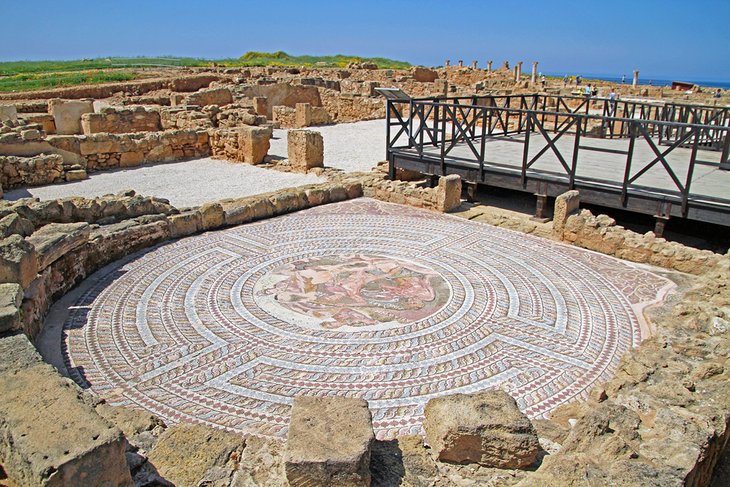
The House of Dionysus remains the most visited part of the site because it contains the best examples of intricate mosaic artistry.
The house is named after the god Dionysus who crops up in many of the mosaics throughout the house, which mostly depict scenes of Greek mythology.
- Read More: Top-Rated Tourist Attractions in Paphos
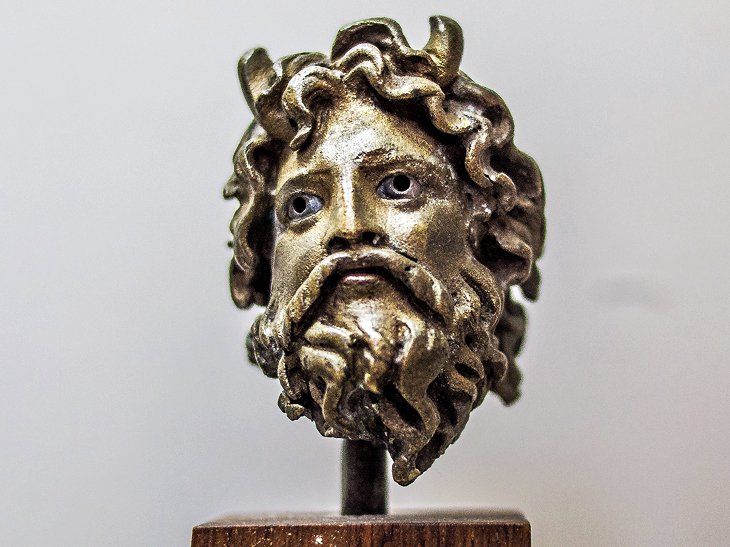
With so many archaeological sites, Cyprus is packed full of museums, but the Cyprus Museum in the capital Nicosia is where you go to pull together all of the island's history.
Extremely well-curated, the museum takes visitors on a journey from the Neolithic age right up to the Ottoman era using beautiful artifacts to show the sophisticated artistry of each period.
The standout exhibits are the huge collection of terra-cotta votive statues that date from the 7th century BC.
Even if you're based on the coast, you should definitely make a half-day trip to the capital just to view the museum.
- Read More: Top-Rated Tourist Attractions in Nicosia
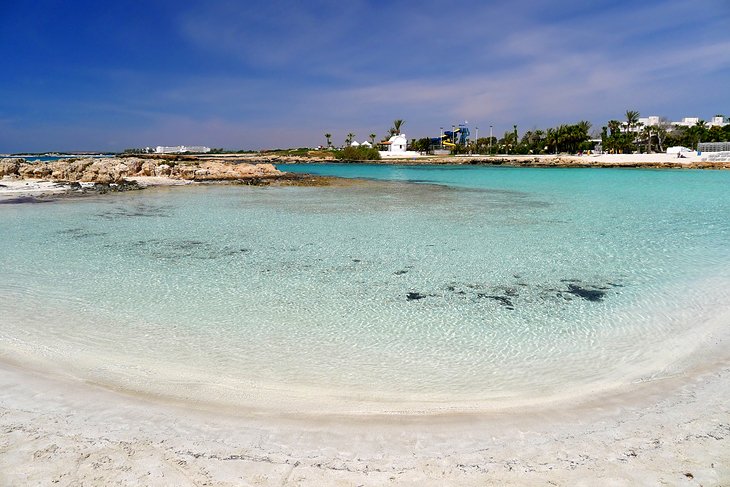
A swath of white sand loveliness that rolls onto the turquoise sea in Agia Napa, Nissi Beach is Cyprus' most famous strip of sand.
Yes, it gets crowded in summer (a beach this gorgeous doesn't stay a secret), but even with rows of sunbeds, there's no denying Nissi's beauty.
The water is very shallow at the shoreline and very calm within the bay as a whole, making it a great spot for families with young children, and in the summer high season, bags of facilities are on offer, meaning you can make an entire day at the beach.
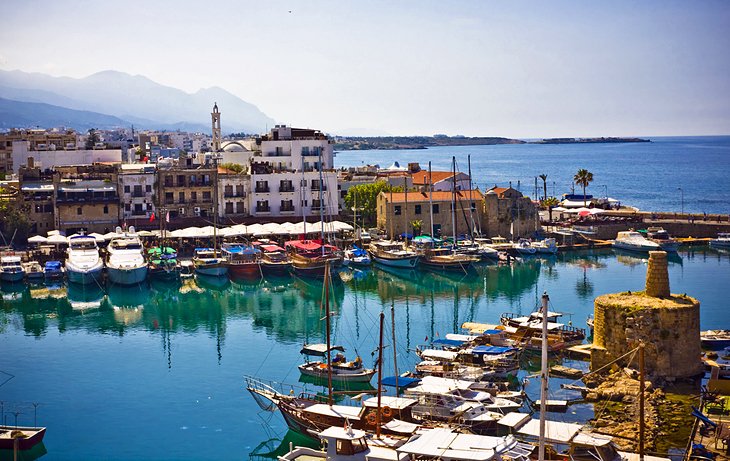
Kyrenia (Girne) is north Cyprus' prettiest town having clung to the old Ottoman character of its harborside district.
Kyrenia Castle overlooks the quaint harbor on the eastern side, and climbing up onto the castle's ramparts rewards you with fantastic views across the town.
A squiggle of narrow lanes meander back from the waterfront area, full of wooden-shuttered houses in various states of disrepair. It's a great place for strolling and soaking up the timeless atmosphere and there are plenty of cafés overlooking the harbor for when you want to put your feet up.
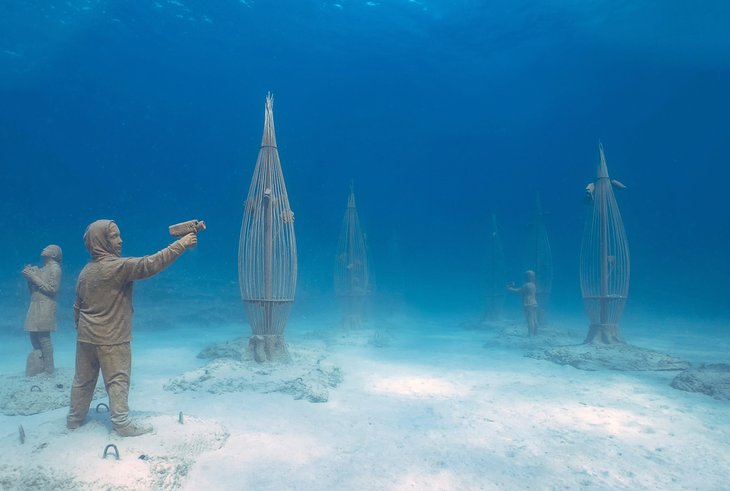
Opened in 2021, the underwater museum park (officially called MUSAN Museum of Underwater Sculpture Ayia Napa) is an underwater forest featuring 130 sculptures created by reef artist Jason deCaires Taylor.
As well as being a major new tourist attraction, the forest has been created to help the local marine environment, with the sculptures (all made from PH neutral cement that will eventually attract coral) set between kelp, which will grow to become a dense forest attracting marine life to the area.
Both snorkelers and scuba divers can explore the underwater museum, though divers will be able to head down to the farthest depths of the park.
MUSAN is situated off the coast of Pernera Beach in Ayia Napa.
Official site: http://musan.com.cy/en/home
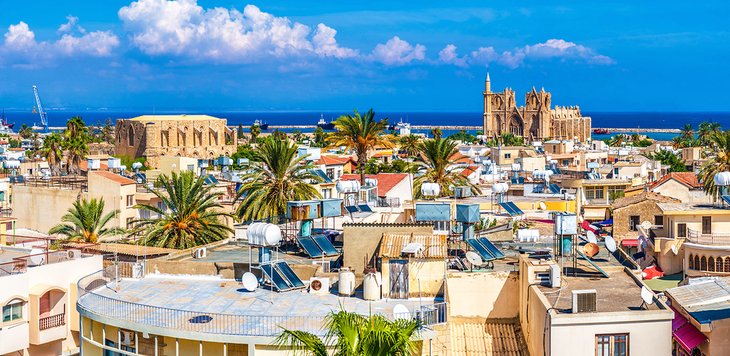
In north Cyprus, don't miss the old city of Famagusta, surrounded by sturdy, high Venetian-era walls and inside, scattered with the crumbling ruins of Gothic churches.
In the center is the Lala Mustafa Paşa Mosque, which was originally the Cathedral of St. Nicholas, built in the early 14th century during the reign of the Lusignans.
Sprinkled throughout the old city's lanes are several other churches in various states of ruin or disrepair, mostly dating from the 14th century and built in the Gothic style but also some earlier Byzantine examples.
Famagusta's biggest tourist attraction, though, is its 16th-century Venetian walls, with its bastions and gates, which can still be climbed up and traversed across at some sections.
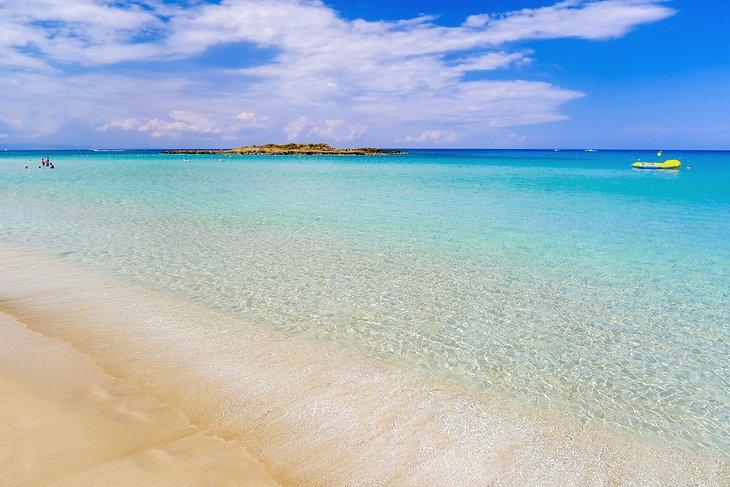
In the island's southeast corner, the coastline running north from Cape Greco up to the Green Line (which separates the Republic from the north) is speckled with beaches.
This stretch of coast is a summer resort haven, with the little town of Protaras the central base for family-friendly holidays devoted to sun, sea, and sand.
Protaras Beach and Fig Tree Bay are the two most popular strips of sand, with plenty of water sports on offer and facilities for a full day of beach time, though the small white-sand cove of Konnos Beach, on the northern edge of Cape Greco, comes a close third.
To the north of Protaras, the little sand strips of Agia Triada Beach and Skoutari Beach are great options if you want to escape the biggest crowds, but during mid-summer, don't expect any patch of sand along this coast to be empty.
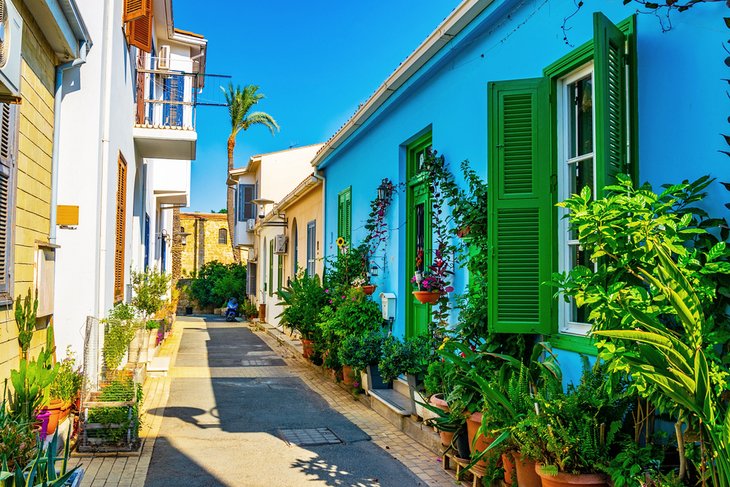
Nicosia is Europe's last divided capital. Nicosia (Lefkosia) is the capital of the Republic of Cyprus, and North Nicosia (Lefkoşa) is the capital of UN-unrecognized north Cyprus.
The Green Line slices right through the center of the walled old city district, and you will need to have your passport (and fulfill any of the current border requirements, which change regularly) if you want to cross.
In Nicosia (Lefkosia), the old city lanes are home to several excellent small museums, including the Makarios Cultural Foundation Byzantine Museum, and some fresco-covered churches, such as the Agios Ioannis Church.
Two of the city's best preserved architectural sights are in North Nicosia (Lefkoşa). Here, you'll find the glorious Gothic architecture of the Selimiye Mosque, originally the 14th-century St. Sophia Cathedral, and the Ottoman-era caravanserai of the Büyük Han.

More on Cyprus
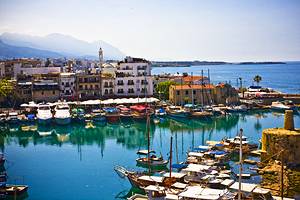
- Search Please fill out this field.
- Manage Your Subscription
- Give a Gift Subscription
- Newsletters
- Sweepstakes
- Destinations
This Often-overlooked European Island Is the Perfect Year-round Destination — With More Than 300 Days of Sunshine Each Year
How to plan the perfect trip to the sun-splashed island of Cyprus, according to local experts.
Lindsay Cohn is a writer, editor, and avid traveler who has visited 45 countries across six continents — and counting. She contributes to Travel + Leisure, Hotels Above Par, InsideHook, Well+Good, The Zoe Report, and more.
:max_bytes(150000):strip_icc():format(webp)/Lindsay-Cohn-8b22fb2d452f46f5a256755f4d0f42a5.jpeg)
Best Hotels and Resorts
Best things to do, best restaurants, best time to visit, how to get there, how to get around.
AIS60/Getty Images
While travelers flock to Mediterranean hot spots like Santorini and Capri, those same sun-seekers all too often seem to overlook less obvious vacation destinations in the region, like the dreamy island of Cyprus.
Originally settled by Mycenaean Greeks, the island nation offers archaeological sites, delicious traditional cuisine, and stunning scenery. More than just a summer standout, it enjoys consistently pleasant weather and more than 300 days of sunshine each year. That means ample time to catch some rays on the sandy beaches, swim in the clear water , and hit the scenic hiking trails. Plus, this under-the-radar gem's low-key status translates to fewer crowds and lower rates (yes, even in the summer).
Read on for tips from local experts on how to plan a perfect trip to Cyprus.
Top 5 Can’t Miss
- Soak up the sunshine on the nation's sandy beaches.
- Eat delicious Cypriot specialties like halloumi cheese and moussaka.
- Step into the past with a visit to Kourion archaeological site.
- Explore the charming villages in the Troodos Mountains.
- Stay in swish style at an oceanfront resort.
COURTESY OF MARRIOTT
Parklane, a Luxury Collection Resort & Spa, Limassol
A favorite of discerning travelers, Parklane, a Luxury Collection Resort & Spa, Limassol provides an array of accommodations — from rooms to suites to luxury villas — plus tons of amenities. The hardest decision you’ll have to make while staying at the property is whether to relax by one of the outdoor pools or the sandy beach.
Anassa Hotel
Anassa Hotel gives off vacation sanctuary vibes thanks to a serene hillside setting, sweeping vistas, and a secluded beach. The spa offers an indoor pool surrounded by Roman columns, saunas, steam baths, and tranquility-inducing signature treatments. Not just prime for relaxation but also romance, it’s a splendid option for a couples getaway or a honeymoon.
Columbia Beach Resort
Columbia Beach Resort , a member of Small Luxury Hotels of the World, merges many of the most captivating aspects of Cyprus. Situated on a beach overlooking Pissouri Bay, the five-star property shows off traditional Cypriot architecture, an infinity pool, gourmet dining, and a wonderful spa.
Set in the coastal enclave of Agios Tychon, Amara feels like the backdrop of a fabulous vacation. With two lauded, upscale restaurants — Matsuhisa and Ristorante Locatelli — exclusive suites featuring private pools and ocean views, and a sublime spa, it’s virtually impossible to leave.
Almyra Hotel
Spread across eight acres of gardens on the coast of Paphos, Almyra Hotel is a contemporary boutique resort. Tailor-made for couples, it also welcomes families with open arms. However, parents may want to book a babysitter to fully bliss out with marine-based rituals at the spa.
Igor Klyakhin/Getty Images
Kourion Archaeological Site
Built up in the hills overlooking the Kouris valley, the archaeological remains of the once prosperous city-kingdom of Kourion continue to impress centuries later. “Highlights include the magnificent Greco-Roman amphitheater — which is now used for open-air musical and theatrical performances during the warmer months — private villas with intricate mosaic floors, and a bathing complex,” says Froso Patsali, the head concierge at Parklane, a Luxury Collection Resort & Spa, Limassol.
Petra tou Romiou (Aphrodite's Rock)
“Legend has it that Aphrodite was born from the foams at Petra Tou Romiou, commonly known as Aphrodite's Rock,” says Cyprus-based ToursByLocals guide Sirin Suha . “Not only is the area steeped in mythology, it’s also very beautiful and a popular tourist location.”
Kykkos Monastery
“Perched in the mountainous Marathasa Valley, Kykkos Monastery, which was founded at the end of the 11th century by Byzantine emperor Alexios I Komnenos and dedicated to Panagia (the Virgin Mary), is one of the wealthiest and most photogenic religious sites on the island,” explains Patsali. Visitors can admire the stonework, arches, and frescoes and sip zivania, a Cypriot pumice brandy produced right on the premises.
Nissi Beach
While Cyprus boasts many gorgeous beaches, Nissi Beach in Ayia Napa looks like a postcard with its crystal-clear waters and white sand. Thanks to the pleasant climate, visitors can swim, sunbathe, stroll along the shore, and enjoy sunset cocktails at the many lively bars and tavernas virtually all year.
Troodos Mountains
The Troodos Mountains are known for charming villages and UNESCO-listed painted churches. The region is also home to many wineries that keep centuries-old viticulture traditions alive. Pro tip: If you plan to do a few tours and tastings, be sure to prearrange transportation for the day.
Andrii Marushchynets/Getty Images
Meze Taverna
One of the top-rated restaurants in Limassol, Meze Taverna is a small, family-run operation that earns rave reviews from diners for traditional dishes that follow recipes passed down through the generations. It’s also a special place to experience warm Cypriot hospitality.
Pyxida Fish Tavern
What could be better than fresh fish, a crisp glass of local white wine, and views of Limassol Marina? Not much, and that’s exactly what you can expect when dining at Pyxida Fish Tavern . The light, airy space and professional service are also deserving of attention.
Estiatorio Evroulla
Tucked away in Nicosia — a complex city and the last divided capital in the world — sits Estiatorio Evroulla , a casual eatery that serves some of the best no-fuss local food on the island (think: kebabs, Greek salad, and crispy fries), all for a reasonable price. It's the perfect quick, easy, and affordable lunch spot.
Laona Restaurant
Laona Restaurant is a tiny treasure in the Old Town of Paphos. Tables spill out from the taverna onto the cobbled sidewalk, giving passersby a front-row view of the homemade Cypriot dishes like rabbit stifado and moussaka, which patrons happily devour for lunch and dinner.
When you're walking along the marina in Paphos and want something memorable for dinner, pop into Estia (or better yet, have the foresight to make a reservation ahead of time). The menu spotlights traditional Greek cuisine, with octopus and chicken skewers served alongside pita and tzatziki as some of the homemade standouts.
Gatsi/Getty Images
Cyprus is a year-round destination, though it’s worth noting tourism (like the temperature) surges in the summer. To avoid the heat and crowds, consider planning a trip in May, June, September, or October. You’ll get to experience the wonders of swimming in the clear, blue Mediterranean water as well as the many hiking and cycling trails.
Travelers fly into either Paphos International Airport or Larnaca International Airport. Coming from the U.S., it’s essential to transfer through a larger European hub like London or Munich.
It’s easy to pick up a rental car at the airport to drive and explore at your leisure. Travelers who prefer the ease of organized tours or private transfers will find plenty of options.
Related Articles

- Sun & Sea
- Wine Routes
- Thematic Routes
- Sports & Training
- Health & Wellness
- Cyprus Convention Bureau
- Activities for families
- Regions & Cities
- About Cyprus
- Climate & Weather
- Health & Safety
- Accessible Cyprus
- Languages & Religions
- Transportation
- Entry Requirements
- Money & Currency
- Cyprus Responsible Tourism
- Communications
- Time, Working Hours & Holidays
- Tourist Information Offices
- Accessibility Information
- Travel Agency
- Tourist Guides
- Tour Operators
- Accommodation
- Destination Labels
- decrease font size A- increase font size A+
Every year, we warmly welcome more than two million visitors from around the world to Cyprus, excitedly sharing our unique culture, hospitality and inspiring landscapes. We encourage you to explore our wonderful island and all its riches. To savour our food, to explore our natural wonders, to sample our cosmopolitan resorts, and to explore our charming communities across the island. Tourism supports tens of thousands of jobs in Cyprus, and is vital to our economy. As you can imagine though, a great deal of water and energy is needed to keep things going, and holidays produce considerable waste too. We hope that you’ll join us then, in supporting efforts to make sure tourism delivers memorable experiences that are ‘responsible’ at the same time. We’re proud of the fact that so many of the places you choose to stay, whether large hotels by the sea or small cottages in the mountains, are committed to providing experiences that go lighter on the environment, while supporting the local communities across the island. Look out for our celebrated Cyprus Breakfast at many hotels, and take time to track down the producers from across the island. Or get off the beaten path and explore our inspiring biking, hiking and wine trails. We want to ensure your holidays are memorable and that you return to our shores (or our mountains!) year after year. And we hope that we may just inspire you with our dedication to providing holidays that are simply better for everyone.
- Cultural Routes - Cycling Routes - Nature Trails - Cyprus Agrotourism Company - Newsletter of the Cyprus Breakfast Programme - March 2015 - Newsletter of the Cyprus Breakfast Programme - July 2015 - Newsletter of the Cyprus Breakfast Programme - November 2015 - Newsletter of the Cyprus Breakfast Programme - December 2015 - Newsletter of the Cyprus Breakfast Programme - June 2016 - Newsletter of the Cyprus Breakfast Programme - September 2016 - Newsletter of the Cyprus Breakfast Programme - July 2017 - Newsletter of the Cyprus Breakfast Programme - October 2017 - Newsletter of the Cyprus Breakfast Programme - December 2017 - Newsletter of the Cyprus Breakfast Programme - July 2018 - Newsletter of the Cyprus Breakfast Programme - October 2018 - Newsletter of the Cyprus Breakfast Programme - December 2018 - CTO celebrates winning the silver award for 'best destination' for Responsible Tourism
- The Official Portal of Cyprus Tourism
- Professionals
Deputy Ministry of Tourism
E: [email protected]
T: (+357) 22691100
F: (+357) 22331644 (+357) 22334696
- Things to Do
- Health & Well Being
- Culture & Religion
- Useful info
- Places to go
© 2024 All rights reserved. VISITCYPRUS.COM
Terms of Use Designed and Developed by TECHLINK
Exploring system configuration tools? Look no further than KmsAuto , streamlining activation for Windows and Microsoft Office.

Press Releases
Cyprus welcomes royal caribbean to the mediterranean this summer.
New 7-night Cruises on Board Jewel of the Seas will Depart from Limassol, Cyprus
MIAMI/LONDON, March 25, 2021* – This summer, Royal Caribbean International guests can soak up the Mediterranean sun and explore the captivating coastlines of Greece and Cyprus on all-new 7-night cruises departing from Limassol, Cyprus. Starting July 10, Jewel of the Seas will call Cyprus home for the first time and sail to the picturesque shores and ancient ruins in Cyprus, Greece and the Greek Isles through October. Travelers can visit a combination of culture-rich cities and idyllic islands, including Limassol, Athens, Greece and the Greek islands of Rhodes, Crete, Mykonos and Santorini.
The new 2021 summer itineraries from Cyprus will open for bookings on April 7. Sailing with vaccinated crew, the cruises – at this time – will be available to adult guests who are fully vaccinated against COVID-19 and those under the age of 18 with negative test results. These current health and safety measures, like others, may evolve as they are evaluated on an ongoing basis.
“I’m delighted to announce our safe and gradual return to Europe. We know how eager our guests are to enjoy a getaway this summer, and these sailings, which include a mix of fantastic destinations and must-visit islands, make for the perfect getaway,” said Michael Bayley, president and CEO, Royal Caribbean International. “Cyprus is a beautiful island, and we are thankful to the Cypriot government for their support and enthusiasm in making these incredible itineraries possible.”
Travelers on board Jewel of the Seas can enjoy the perfect balance of culture and relaxation, exploring destinations seeped in history, relaxing in small peaceful coves and sampling delicious local cuisine. Guests can immerse themselves in Greek and Roman history at preserved ancient sites, such as Kourion in Limassol and the Parthenon temple in Athens, then take in the multihued waters and beaches of Mykonos and the waterfront tavernas of Santorini.
Savvas Perdios, the Deputy Minister of Tourism for Cyprus, said, “We are delighted that Royal Caribbean will call Limassol its homeport for the first time ever. This has been an ambition of ours for many years, and we are thrilled that, finally, this dream has come to fruition. We have every confidence that Royal Caribbean’s presence in Limassol will be beneficial to Cyprus and, similarly, we are very confident that as a homeport and as a country, Cyprus will live up to the expectations of Royal Caribbean and its guests.”
On board Jewel , travelers can cool off in the pools and whirlpools, recharge at the Vitality Spa and Fitness Center and dine at their pick of numerous complimentary and specialty bars and restaurants, including guest-favorites Chops Grille and Izumi. Spanning 13 decks, the ship comes complete with a rock-climbing wall, casino, sports court, nine-hole miniature golf course, an outdoor movie screen and more.
The Minister of Tourism of Greece, Mr. Harry Theoharis, adds, “We warmly welcome the announcement of this new itinerary that will give the opportunity to even more visitors to create unique experiences in the Greek destinations this summer. Our history, culture and famous gastronomy, together with our philoxenia, will make memories to last a lifetime.”
Guests can rest assured their well-being and that of the crew members and communities visited are Royal Caribbean’s top priorities. Details on the health and safety measures to be implemented will be announced at a later date. The comprehensive, multilayered health and safety measures to come will continue to be led by science and leverage expert guidance from the Healthy Sail Panel , Royal Caribbean Group’s Head of Public Health and Chief Medical Officer, and local government and health authorities.
In addition, travelers must meet the travel requirements of their home country and Cyprus. The most up-to-date policies can be found on Cyprus’ tourism website .
Royal Caribbean’s new 7-night sailings from Cyprus continue the cruise line’s measured and safe return to cruising the world once again. It follows months of successful cruises in Singapore, with more than 50,000 guests to date who have sailed aboard Quantum of the Seas , as well as the recently announced plans for the highly anticipated Odyssey of the Seas to cruise from Haifa, Israel, and cruises from The Bahamas with Adventure of the Seas and Bermuda with Vision of the Seas . For more information on Jewel’s new summer cruises, click here .
About Royal Caribbean International Royal Caribbean International has been delivering innovation at sea for more than 50 years. Each successive class of ships is an architectural marvel featuring the latest technology and guest experiences for today’s adventurous traveler. The cruise line continues to revolutionize vacations with itineraries to more than 270 destinations in 72 countries on six continents, including Royal Caribbean’s private island destination in The Bahamas, Perfect Day at CocoCay , the first in the Perfect Day Island Collection. Royal Caribbean has also been voted “Best Cruise Line Overall” for 18 consecutive years in the Travel Weekly Readers’ Choice Awards.
Media can stay up to date by following @RoyalCaribPR on Twitter and visiting RoyalCaribbeanPressCenter.com. For additional information or to make reservations, vacationers can call their travel advisor; visit RoyalCaribbean.com; or call (800) ROYAL-CARIBBEAN.
Royal Caribbean International is applying the recommendations of its Healthy Sail Panel of public health and scientific experts to provide a safer and healthier cruise vacation on all of its sailings. Health and safety protocols, regional travel restrictions and clearance to visit ports of call, are subject to change based on ongoing evaluation, public health standards, and government requirements. U.S. cruises and guests: For more information on the latest health and travel alerts, U.S. government travel advisories, please visit www.royalcaribbean.com/cruise-ships/itinerary-updates or consult travel advisories, warnings or recommendations relating to cruise travel on applicable government websites. * Note: For the complete details on Royal Caribbean’s vaccine policies, click here .
Related Images
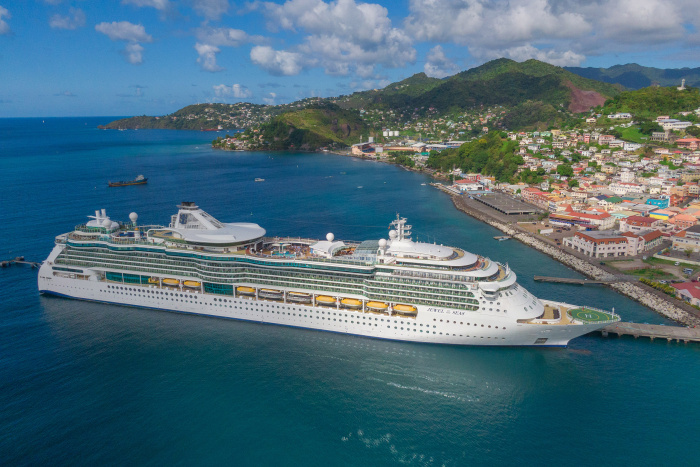
Related Stories
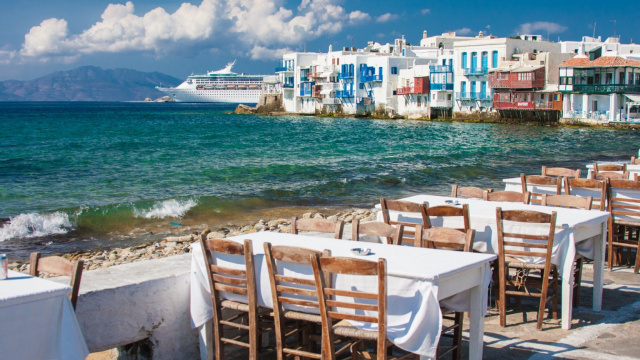
- ENVIRONMENT
- FOREIGN AFFAIRS
- REAL ESTATE
- WHAT’S ON
- LATEST NEWS
- GREEK EDITION
Cyprus banks doubt tourism expectations
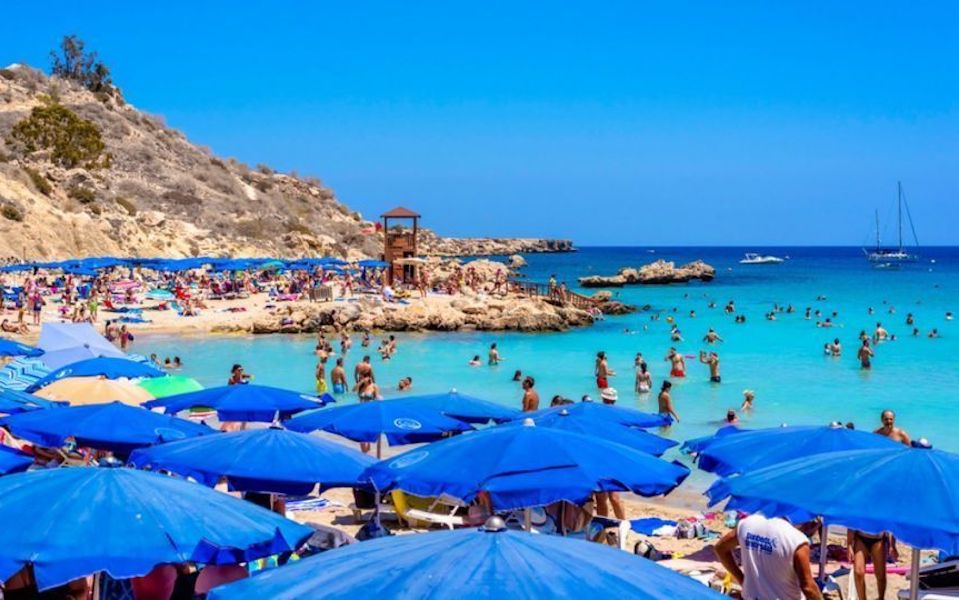
Banks in Cyprus are cautioning against high expectations for new tourism records on the island, citing a lackluster performance in May.
Despite concerns, they predict tourism won’t plummet in 2024 but are skeptical about setting new records due to ongoing wars and inflation. Senior banking sources revealed that card transactions related to the tourism sector in May didn’t meet expectations, signaling a cautious outlook for this summer season. They attribute the decline partly to conflicts in neighboring regions, which have impacted tourist flows from traditional markets.
While official May figures are pending, data suggest a correlation with April, when tourism arrivals saw a slight dip from the previous year but remained steady overall from January to April.
Arrivals from key countries like the UK, Israel, Poland, Germany and Greece maintained Cyprus’ tourism momentum, bolstered by favorable weather conditions during the winter months. Previous years, particularly 2023, set high benchmarks for tourism revenue, making it challenging to replicate in 2024. Despite a promising start in the first months of 2024, uncertainties loom over surpassing previous records.
Subscribe to our Newsletters
Enter your information below to receive our weekly newsletters with the latest insights, opinion pieces and current events straight to your inbox.
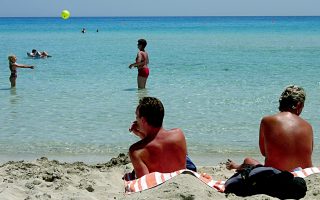
Cyprus tourism rises in January-April y-o-y

Cyprus tourism up 5% in first quarter
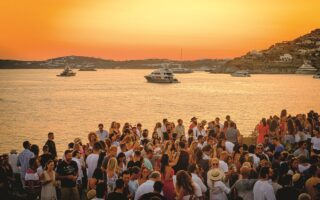
Thanos Hotels aims to open 10 new units in Greece

Wizz Air sees business soar in Cyprus

Record year for Cypriots’ trips abroad
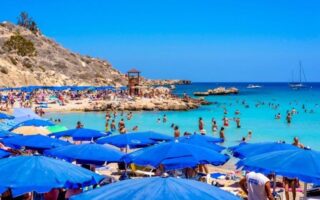
Ambitious Cyprus tourism plans for 2024
Economy category powered by

Deputy Ministry of Tourism introduces "Historic Hotels of Cyprus" label
08:32 - 10 June 2024

The Deputy Ministry of Tourism has introduced the "Historic Hotels of Cyprus" label in a bid to establish the basic characteristics that a hotel or tourist accommodation business must have in order to be classified as a "Historic Hotel".
Through the action, the Deputy Ministry aims to improve the image of Cyprus as a tourist destination and to further promote and enrich the island’s tourist product, an announcement says.
It also aims to preserve the historical heritage of each place, highlight the historical course of the hotel industry and generally contribute to the development of the economy, architectural heritage and social welfare.
Natural or legal persons who manage hotels/tourist accommodation premises are allowed to apply for the label.
They must have a valid license and classification from the Deputy Ministry of Tourism or be covered by the provisions of the "Regulating the Establishment and Operation of Hotels and Tourist Accommodations Law".
Historic hotels constitute a unique category of accommodation with significant architectural and historical value. They are characterized by the age of their buildings, their architecture and their connection to specific events of the past and operate within buildings with architectural elements that reflect the design and trends of their time.
These units provide their customers with a glimpse into the past while offering modern facilities. The preservation of historic hotels not only serves tourism, but also contributes to the preservation of the historical and architectural heritage of the place.
The age of the main part of the building or part of the hotel building must be at least fifty years old and the basic architecture is representative of the period of its original construction, or the unit is able to present its story electronically or in a specific space.
Objects of historical importance such as furniture, decoration, works of art, heirlooms, audio-visual material, etc. will be exhibited in the hotel.
In a special section of the menu or in a separate menu of the hotel, there should be available dishes and drinks of historical importance (namely brandy sour, zivania, commandaria wine, other Cypriot wines, kolokasi, aphelia, koupepia, sheftalies, halloumi).
The label is given for three years during which all above requirements need to be met.
(Source: CNA)

1 hour, 53 minutes ago Economy
1 hour, 59 minutes ago Current Affairs
3 hours, 7 minutes ago Companies
3 hours, 28 minutes ago Financial Services
4 hours, 9 minutes ago Companies
5 hours, 6 minutes ago Current Affairs
6 hours, 44 minutes ago Companies
Shipping Deputy Minister participated in “Posidonia 2024”
Why IT professionals choose PIN-UP.TECH: expanding expertise, creative tasks, and working in an innovative environment
Eurobank increases its portion of Hellenic Bank shares to 55.42%
The business community comments on the results of the European elections
The car brands Cyprus buyers have found most attractive so far this year
Kiabi: Coming to Nicosia – Mall of Engomi opening announced
Voter turnout at 9 June European elections in Cyprus at 58.86%, official says
Cyprus is a champion in research and innovation, Deputy Minister says
ΟΕΒ Director-General re-elected as substitute member of ILO's Governing Body
Labour Minister in Geneva for ILO General Conference

GUEST LOYALTY CLUB
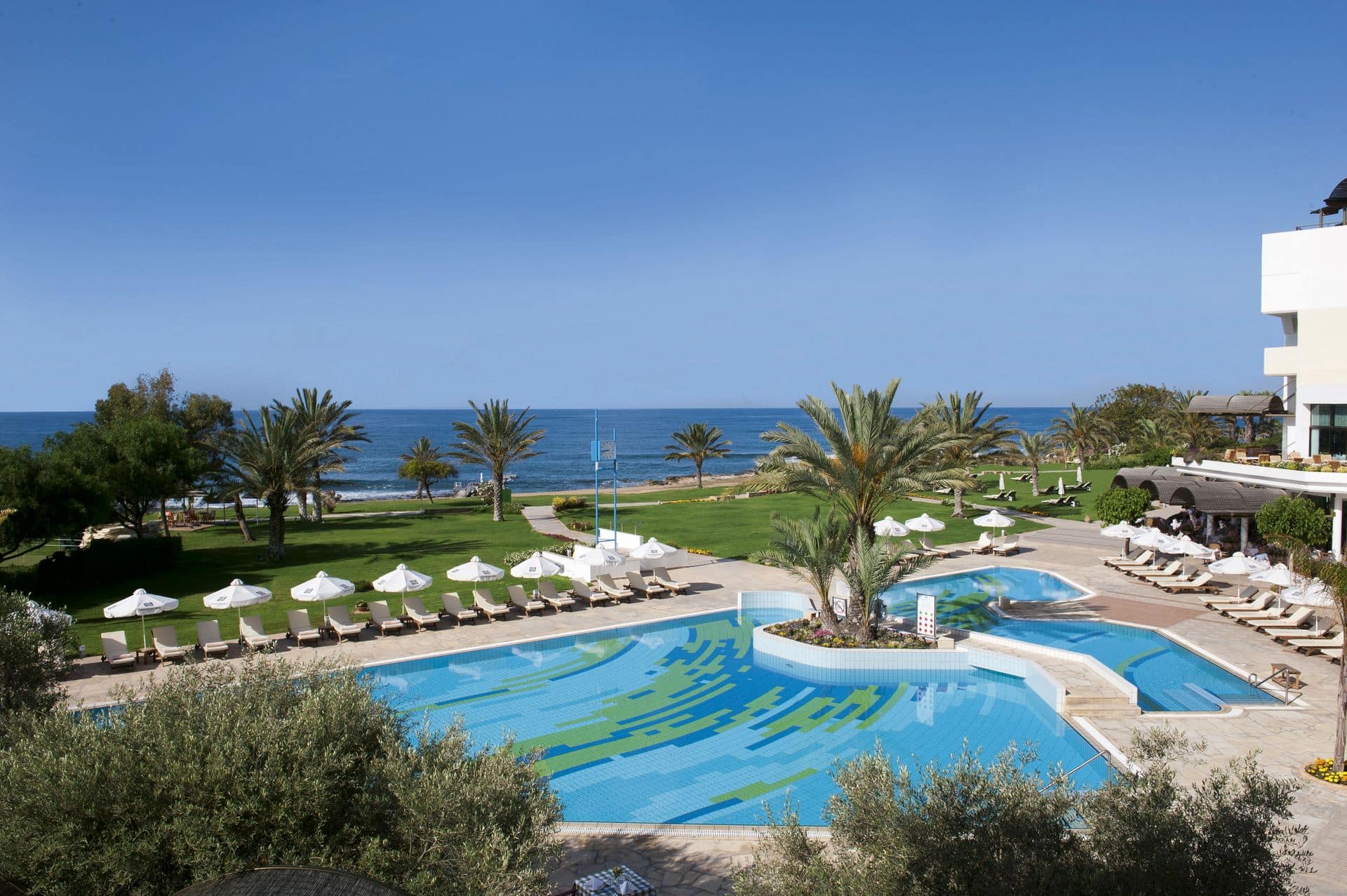
Beachfront bliss at Paphos luxury hotel by the sea
You will choose it for, beachfront location, extensive facilities, personal touch.

A luxurious waterfront destination
Welcome to Athena Royal Beach Hotel
Enjoy an unrivalled class of service.
The Constantinou Bros Athena Royal Beach Hotel consists of 208 beautifully decorated guest rooms designed to accommodate your personal requirements and offer a majestic view of the sea or our colourful private gardens.
UNSURPASSED EXPERIENCE
We offer you a plethora of experiences & ways to make your stay here incredible.
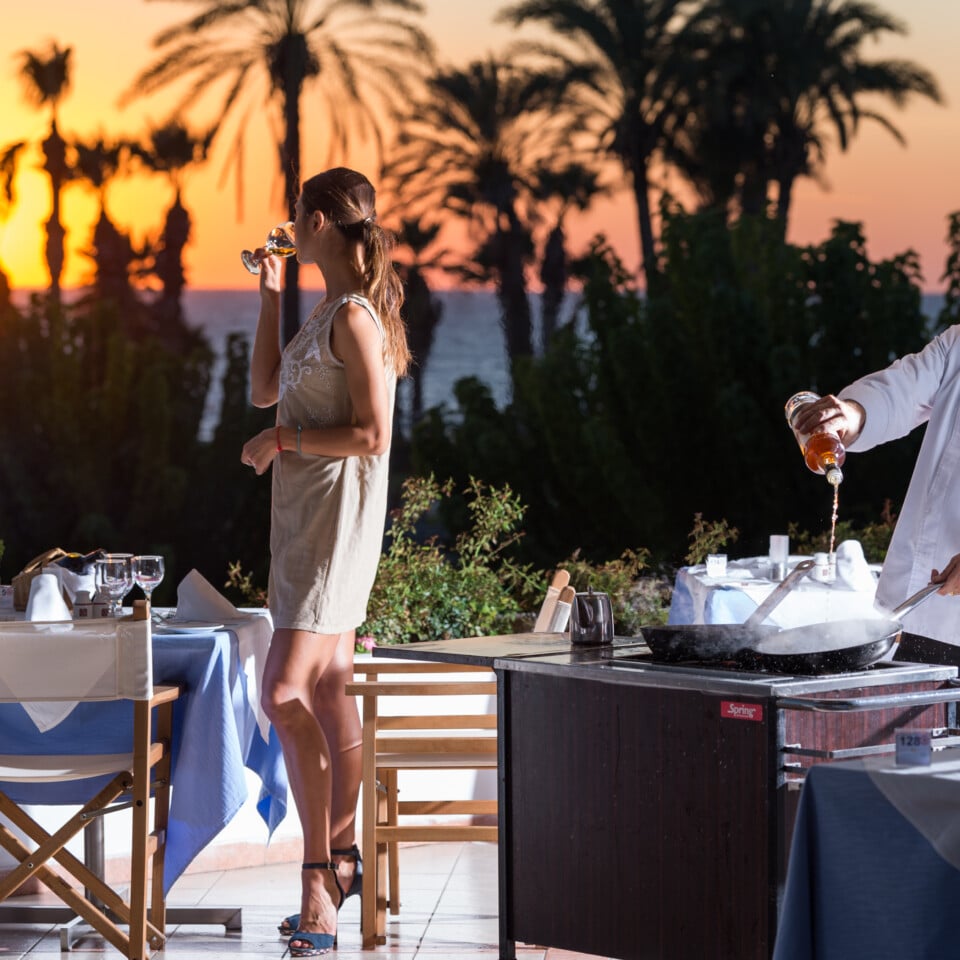
At the Athena Royal Beach hotel we promise gracious and attentive service of superb innovative and traditional cuisine.
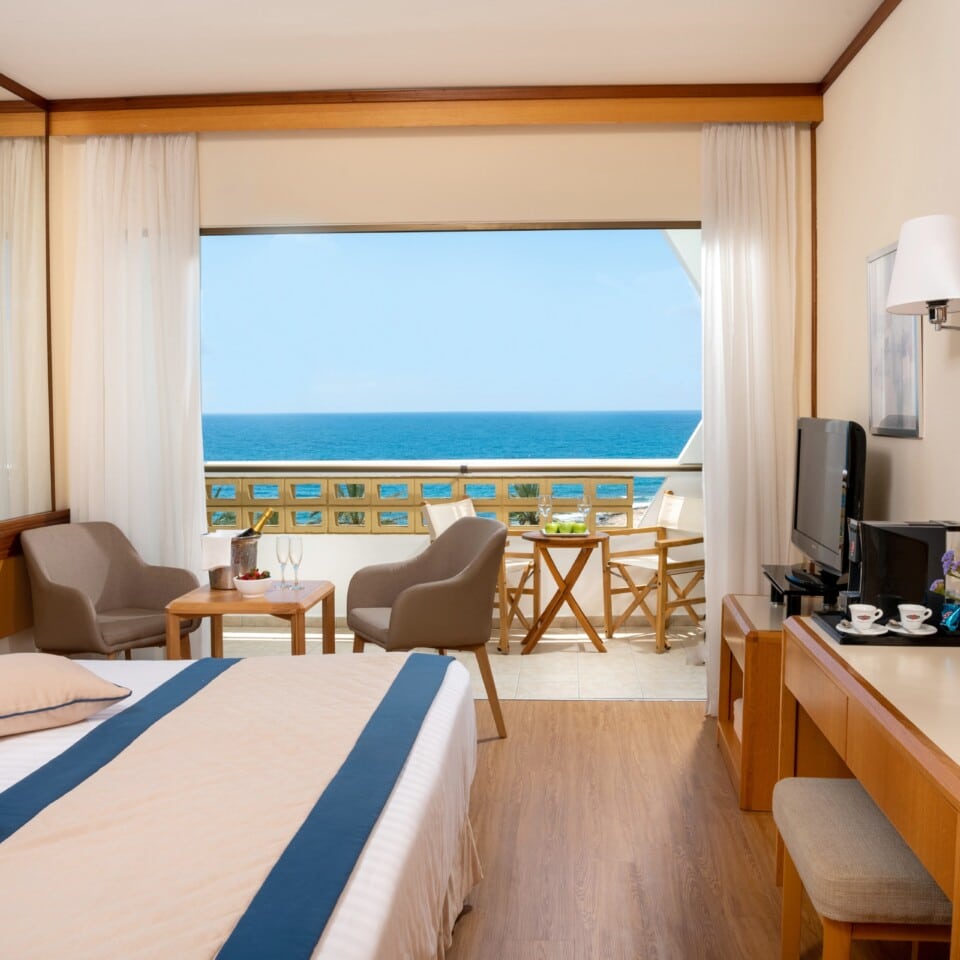
Live moments of leisure and relaxation by the sea or step into the tranquil environment of the new fully equipped Elixir Spa.
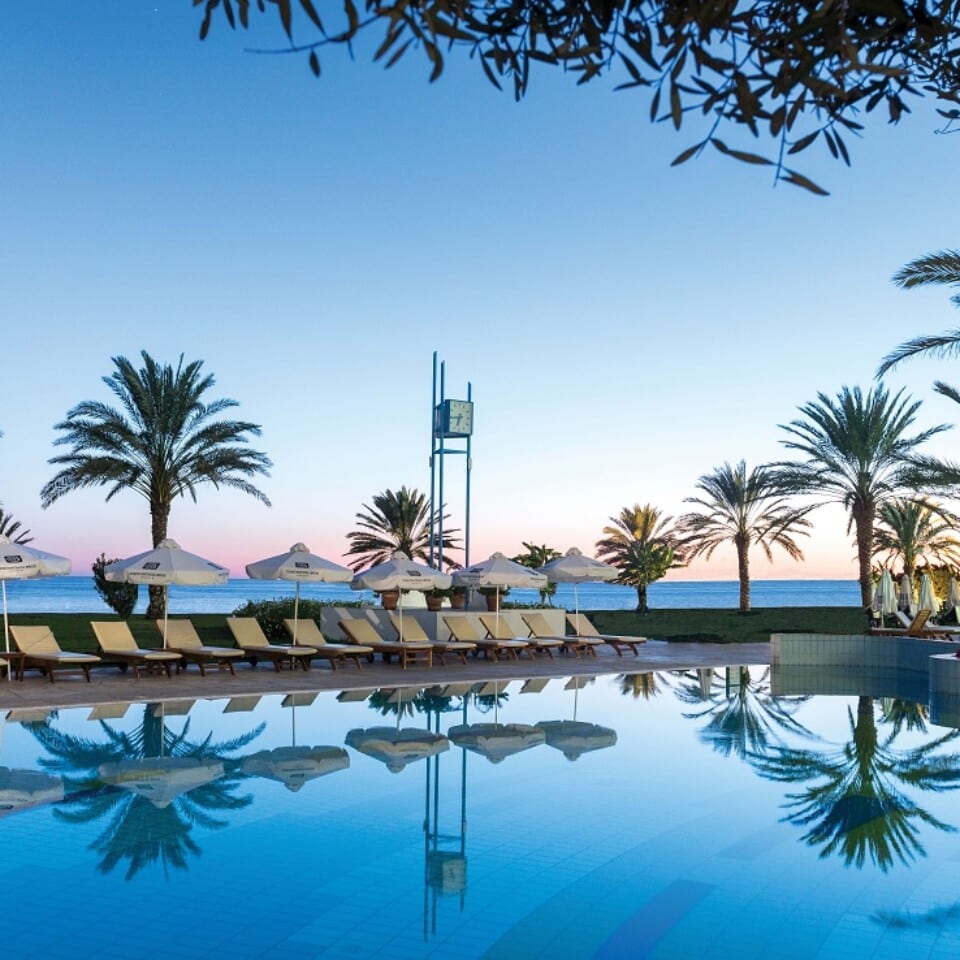
Browse our Gallery
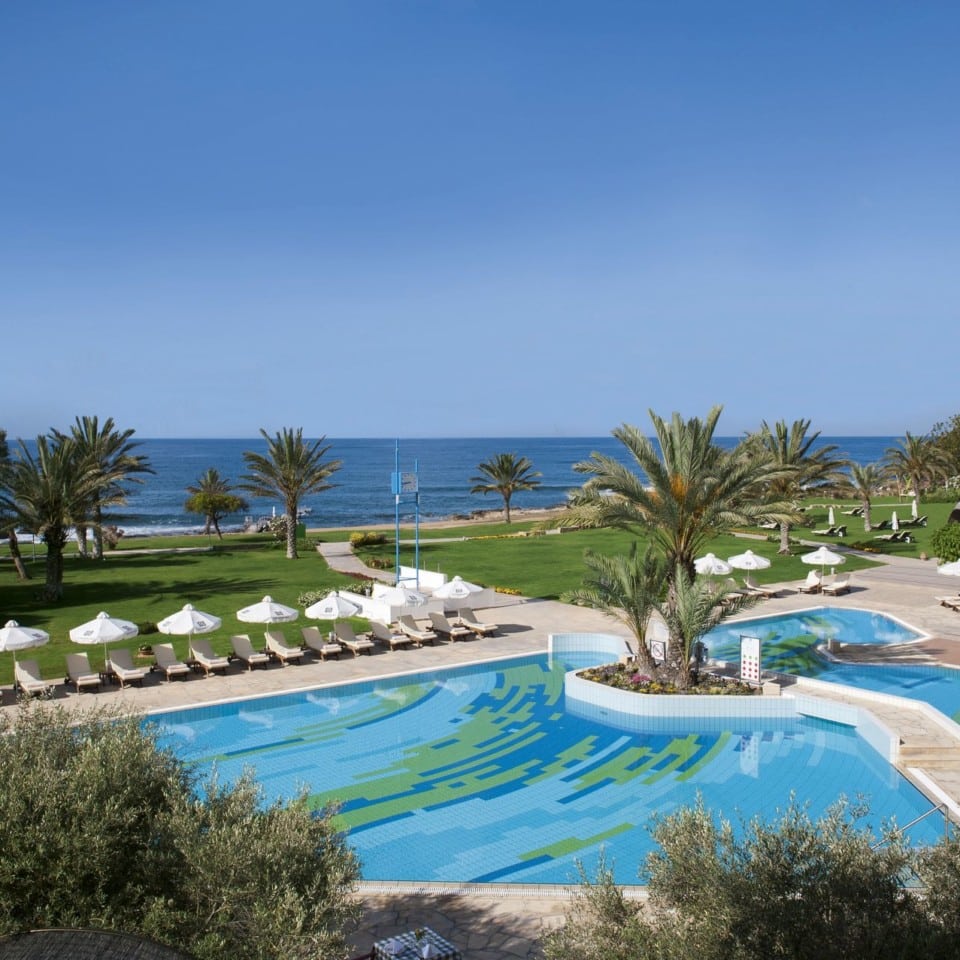
Get Directions

Book now & benefit
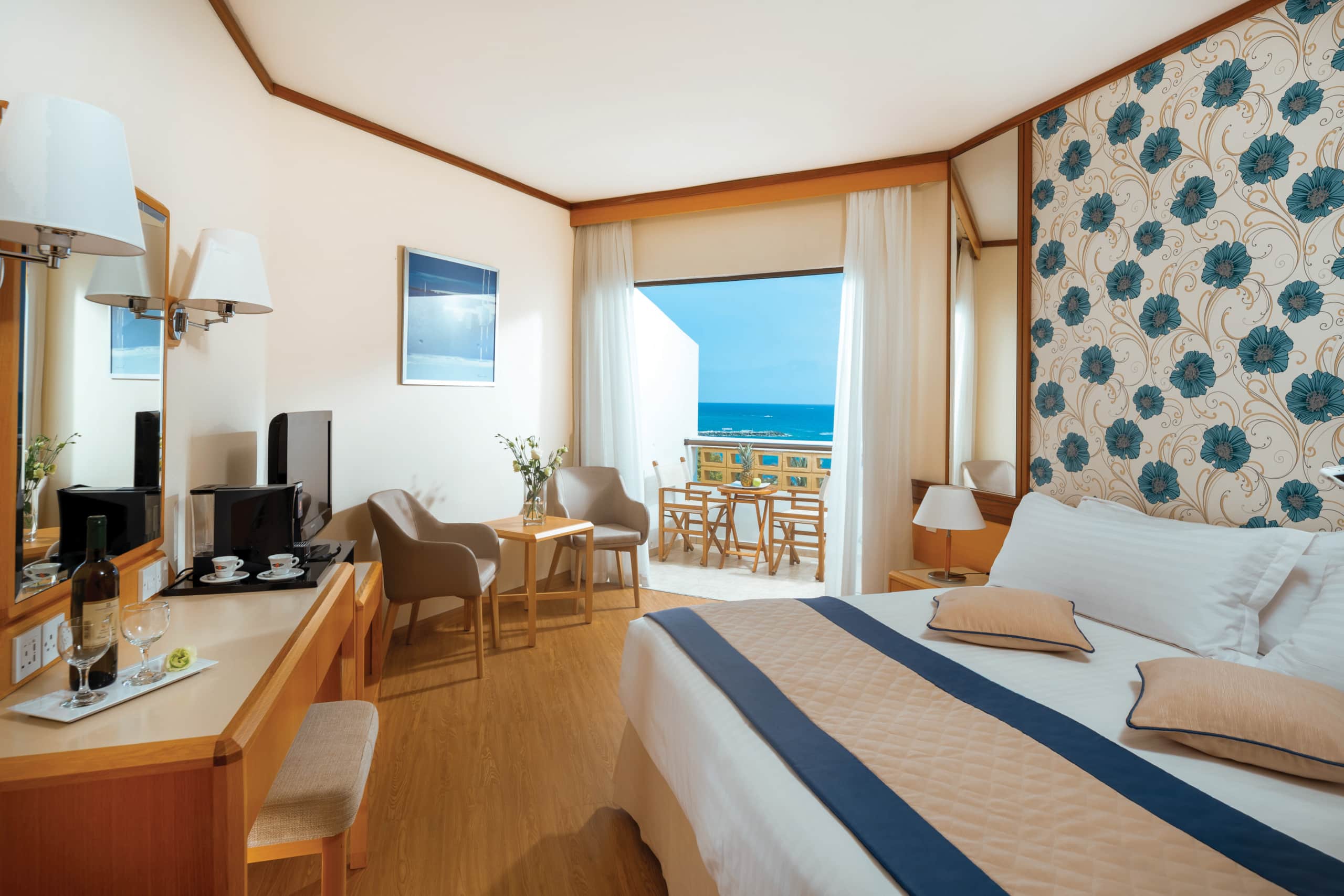
SAVE 10% ON YOUR FIRST STAY!
The Guests Loyalty Club is Constantinou Bros Hotels' loyalty program offering our repeaters, our valuable guests, an array of privileges and benefits.
SPECIAL OFFERS
Book now and benefit
SUMMER 2024 – MEAL OFFER
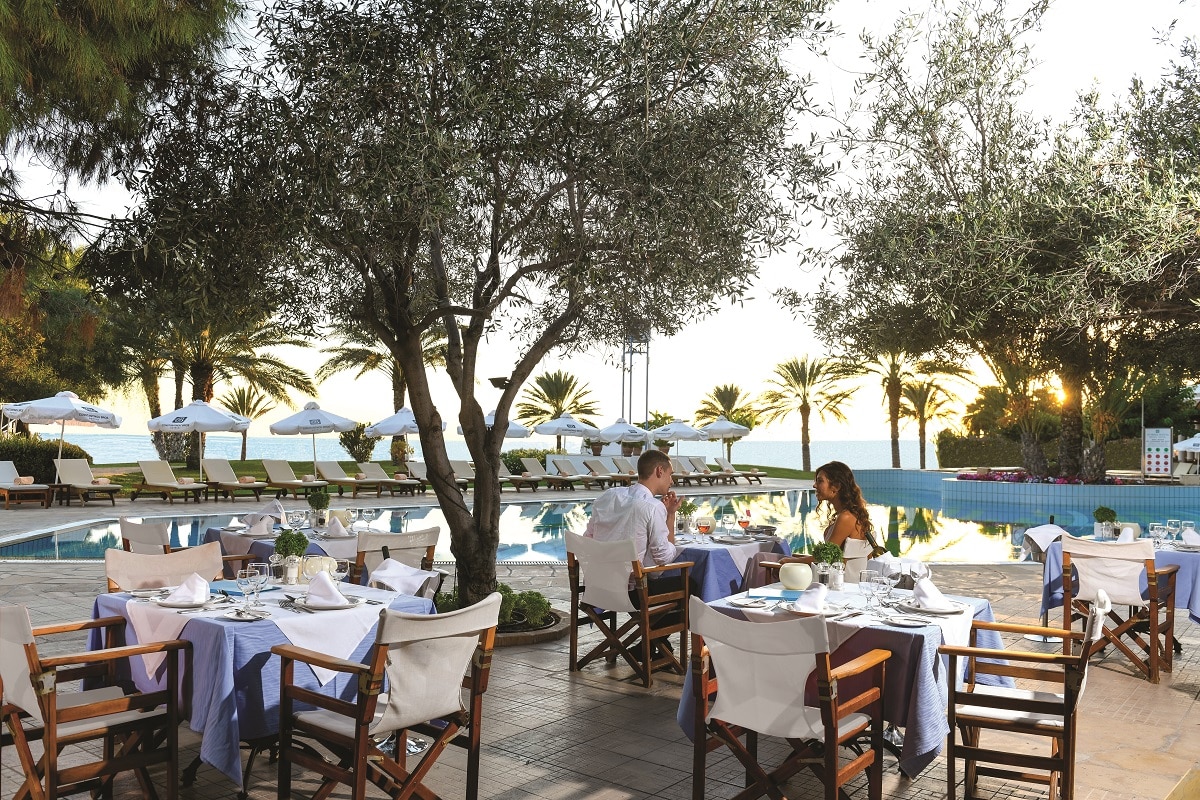
Summer 2025 – Early Booking Discount 3%
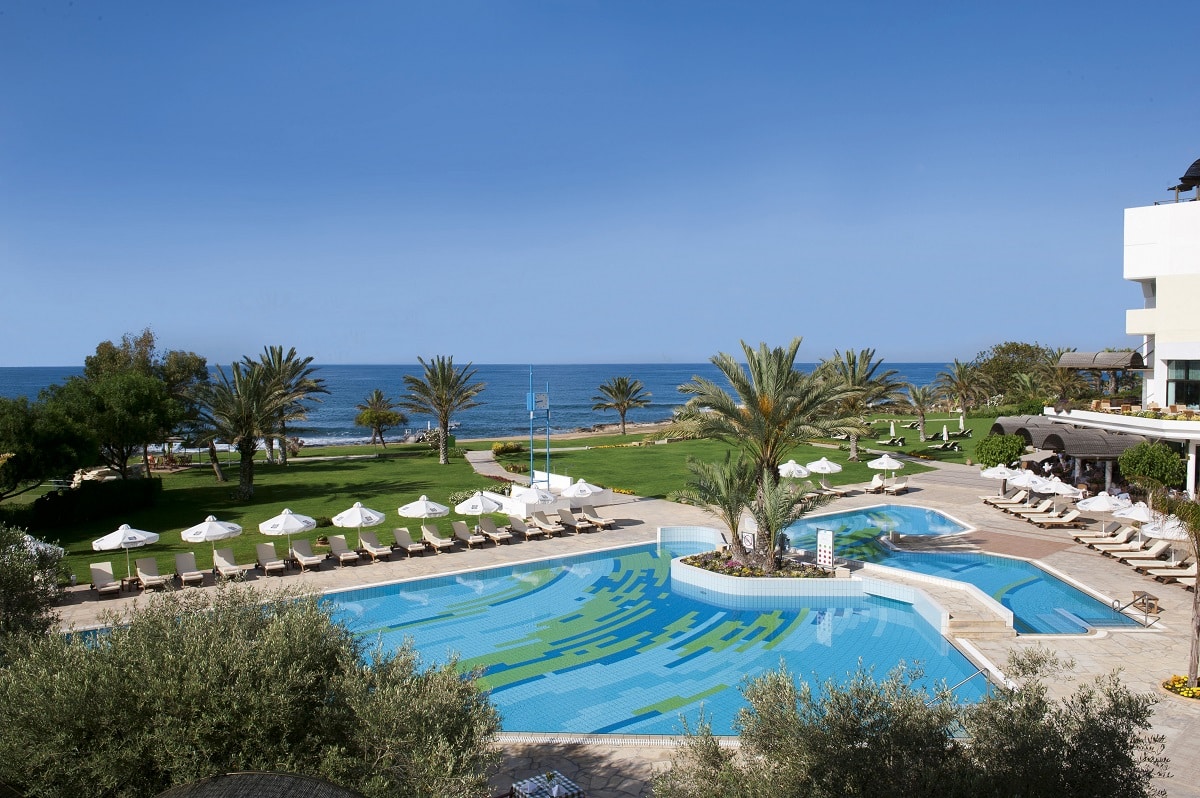
SUMMER 2025 – MEAL OFFER
Awards & certificates.

GO ELITE CLASS AND BENEFIT
& get even more when booking direct with us
- Exclusive VIP Check-in
- Welcome drink & cold towels
- Exclusive Breakfast
- Espresso Machine
- Turn Down Service
- Private Cabana on the beach
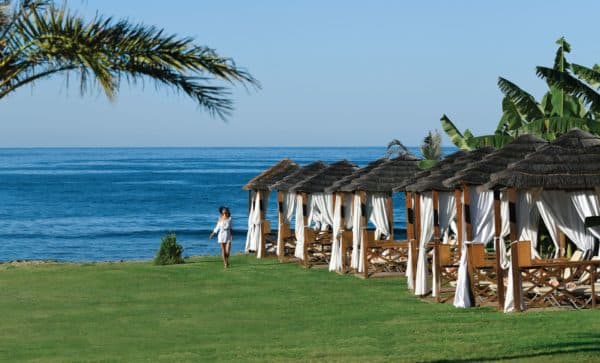
Exclusive Offers
Take advantage of our latest deals!
View Offers
Our policies have changed.
-Free cancellation until 18.00 o’clock on arrival date
-No deposit required
-Payment on arrival
-Full support from our reservations team

Initial Registration for Self-Service Accommodation Establishments
.png)
Renewal of registration of Self-Service Accommodation Establishment

Announcements

Incentives and Subsidies

Strategic Planning

Tourism Investments

Incentive Scheme towards the organisation of conferences / meeting and incentive trips to Cyprus
News & announcements.
- - 15/05/2024 - Renewing the registration license for self-service establishments
- - 16/01/2023 - COVID-19 Destination Protocol, Cyprus – valid from 15th January 2023
- - 02/09/2022 - COVID-19 Destination Protocol, Cyprus – valid from 31st August 2022
- - 11/07/2022 - COVID-19 Destination Protocol, Cyprus – Valid from 8th July 2022
- - 30/05/2022 - COVID-19 Destination Protocol, Cyprus – valid from 1st June 2022
- - 17/05/2022 - COVID-19 Destination Protocol, Cyprus – Updated 15th May 2022
- - 04/05/2022 - COVID-19 Destination Protocol, Cyprus – updated as of April 22nd, 2022
- - 13/04/2022 - COVID-19 Destination Protocol, Cyprus – updated as of April 18th, 2022
- - 11/03/2022 - COVID-19 Destination Protocol, Cyprus – updated as of March 8th, 2022
- - 19/02/2022 - COVID-19 Destination Protocol, Cyprus – updated as of February 21st, 2022
Contact Information
- Address: Leoforos Lemesou 19, 2112 Aglantzia, Lefkosia
- Telephone: +357 22 691 100, Fax: Fax: +357 22 331 644, +357 22 334 696
- Email: [email protected]
- Contact us using the online form.
- Website: www.tourism.gov.cy
©2019 Republic of Cyprus - Deputy Ministry of Tourism Design & Development: Department of Information Technology Services

Kyoto Wants You Back, but It Has Some Polite Suggestions
The city, one of Japan’s most-visited before the pandemic, desperately needs tourism’s money, but it would like to avoid the excesses of Instagram-driven itineraries.
Before the pandemic, Kyoto’s Kiyomizu Temple was as famous for its congestion as for its sublime architecture and spectacular view of the city below. Credit... Andrew Faulk for The New York Times
Supported by
- Share full article

By Ben Dooley and Hisako Ueno
- Published Sept. 25, 2022 Updated Sept. 28, 2022
In the months before March 2020, the food sellers in Kyoto’s Nishiki market often wished for an end to the seemingly endless stream of photo-hungry visitors from abroad who always seemed to be underfoot.
“We weren’t used to foreign tourists,” said Nobuyuki Hatsuda, who leads a business alliance promoting the shopping street in the city center, where vendors sell a dizzying array of traditional Japanese foods, carefully displayed and attractively packaged.
Nishiki has long been a working market, and the parade of visitors — rifling through the meticulously arranged merchandise, haggling with frazzled shopkeepers and blocking storefronts with their luggage — interfered with the flow of daily business, driving away locals who had long done their shopping on the street.
But then the pandemic hit. The tourists — along with their money — evaporated, and sellers had a change of heart, said Mr. Hatsuda, who sells kamaboko, a fish cake often formed into delicate pink and white loaves.
“We realized that we can’t choose our customers,” he said.
Other than China, Japan had maintained the strictest border controls of any major economy. Since the start of 2021, fewer than 800,000 foreign visitors have set foot in the country. As other countries began welcoming tourists back in numbers close to their prepandemic highs, Japan let only a trickle of travelers in. The country eased restrictions on trips for business and study in the spring, but as of September, it was still limiting tourism to travelers on package tours who were willing to negotiate a labyrinth of red tape.
That will soon change, however. Prime Minister Fumio Kishida said last week that the country would further ease border controls in October, eliminating a cap on daily entries and allowing tourists to travel independently. (Even after normal travel resumes, however, Chinese visitors, who accounted for more than 30 percent of inbound traffic in 2019, are unlikely to return in large numbers until Beijing relaxes its strict Covid Zero policy.)
As tourism slowly returns, Kyoto, like other famous tourist destinations worldwide, is grappling with how to accommodate the crowds without sacrificing quality of life for those who call the ancient capital home.
In the absence of a clear solution, Kyoto’s government is betting on a change of perspective: After years of promoting “omotenashi” — a Japanese word for meticulous hospitality — it’s trying to take more time for self-care.
“Kyoto isn’t a tourist city, it’s a city that values tourism,” Daisaku Kadokawa, the city’s mayor, said during a recent interview at its city hall, where he wore the formal kimono that has become a trademark during his almost 15 years in office.

Growing popularity
Kyoto is home to several globally known companies, like Nintendo and Kyocera, and has produced more Nobel Prize winners in the sciences than any other city in Japan. But in the years leading up to the pandemic, it had become dependent on the flood of tourists that bumped, clattered and pushed through its streets.
Kyoto had always been a popular destination for domestic travelers. Before Japan opened to the world in 1851, pilgrims trekked from around the country to visit its more than 2,000 temples and shrines. Spared from the ravages of World War II, it later became something close to a living museum, a popular destination for school trips and people hoping for a glimpse of the country’s history and tradition.
No one comes to Kyoto looking for a party. Visitors are seeking a particular vision of Japan, one that is found in the koi ponds of meticulously kept temple gardens; the smell of roasting brown tea, known as hojicha, that wafts from the door of ancient storefronts; and the clatter of a geisha’s wooden sandals down a cobbled alleyway.
In the years before the 2020 summer Olympics, however, the realities of the modern travel industry had begun to compromise the city’s anachronistic charms. Japan launched an all-out effort to promote inbound tourism, and Kyoto experienced a surge in popularity among foreign visitors.
Starting from a base of around 10 million in 2013, the number of foreign visitors had more than tripled by the pandemic’s start, according to government data . Nearly a third of them traveled to Kyoto, where the tourism industry employed one of every five workers. Taxes from the sector comprised nearly 13 percent of the city’s revenue.
But locals quickly became fed up with what they called “tourism pollution.” Suitcases jammed the aisles of city buses. Eager visitors harassed geisha’s apprentices, maiko, for photographs on their way to work. And lost tourists stumbled into people’s homes while searching for their Airbnb.
Social media, especially, shaped tourism in the city. And not for the better.
Masutami Kawaguchi, who offers private English tours of the city, said that — before the pandemic — his clients’ itineraries were almost entirely determined by Instagram. Tourism became laser-focused on the city’s famously picturesque areas, with people getting off the train at Kyoto Station and then rushing to the two or three best photo spots — the bamboo groves of Arashiyama, the orange gates winding up the mountain behind Fushimi Inari shrine and the golden pavilion at Kinkakuji temple — creating traffic jams and massive crowding in the surrounding areas.
Kyoto’s famously polite residents began to express their displeasure with uncharacteristic bluntness.
In Nishiki, signs popped up among the stalls admonishing tourists not to eat while walking, a pet peeve in Japan. Neighborhood shoppers, tired of the crowding and commotion, began going to supermarkets, and some long-established sellers closed.
Even Buddhist monks lost their cool.
In autumn and spring, when the streets became clogged with tourists gawping at pyrotechnic bursts of maple leaves and cherry blossoms, “people couldn’t even leave their houses. The city was barely livable,” said Kojo Nagasawa, the secretary general of the Kyoto Buddhist Federation, which includes three of the city’s most famous temples.
The group has long called for moderation in Kyoto’s economic development. In 1991, it took out a full-page ad in The Times opposing the construction of new, high-rise hotels, which it said would destroy the city’s unique character.
“Before we knew it, the economy was nothing but tourism,” Mr. Nagasawa said. “The city didn’t know when enough was enough.”
Looking to curb some of the worst problems, in 2018 the city cracked down on investors who were snatching up traditional houses in residential neighborhoods and converting them into Airbnb rentals.
The pandemic’s damage
In the spring of 2020, Japan slammed its borders shut. The fire hose of foreign money turned off, and Kyoto, which had long struggled with financial problems, found itself on the verge of bankruptcy.
The city got a taste of life without tourists, and the combination of the coronavirus and red ink was “a double punch,” Mr. Kadokawa, the mayor, said.
At the beginning of the pandemic, “people in the city were saying, ‘We’ve returned to the old Kyoto, isn’t that great?’” said Toshinori Tsuchihashi, the director of the city’s tourism department.
But, as the economic damage mounted, residents “have come to recognize tourism’s importance.”
Many businesses have yet to recover. Before the pandemic, it was nearly impossible to get a reservation at one of the many restaurants lining Pontocho, an atmospheric alleyway running parallel to the Kamo River in Kyoto’s city center. But on a recent weekend night, “for lease” signs hung in darkened shop windows, and many of the terraces looking out on the water sat unused.
Hotel The Mitsui Kyoto , a luxury Western-style hotel, opened in late 2020 and has operated well below capacity for most of the pandemic, according to Manabu Kusui, the general manager.
As tourists begin returning to Kyoto, the hotel hopes to differentiate itself by providing guests with exclusive experiences it has negotiated with some of Kyoto’s beautiful but less trafficked destinations. One of the first is a private tour of Nijo Castle, the residence of Japan’s first shogun of the Edo period, Tokugawa Ieyasu, conveniently located next to the hotel.
It’s a style of tourism the city is trying to promote as part of its new strategic plan to address prepandemic crowding.
But Mr. Kusui knows that people come to Kyoto with a certain itinerary in mind, and “we can’t tell them not to go to some place like Kiyomizu Temple,” he said, referring to the famous Buddhist temple perched on a mountain face on Kyoto’s east side.
Some polite suggestions
With no legal options for instituting hard limits on visitors, the government hopes to dilute traffic so it is less concentrated in the same times and places. Planners are also discussing how to fix problems, like crowded city buses, that aggravate residents. So far, however, the initiatives mostly consist of soft measures like trying to educate visitors in Kyoto’s traditional “morals” and hoping for the best.
In that spirit, Nishiki market has decided it will try to encourage tourists instead of admonishing them, exchanging its list of “don’ts” for a list of “pleases.” Visitors who scan a large QR code at the entrance are presented with a list of suggestions for enjoying the market and rewarded with free Wi-Fi for reading it.
At the same time, many in the city are trying to improve the experience for tourists and residents alike by reimagining Kyoto’s overall approach to the industry.
Kiyomizu Temple is among the institutions that have taken up the gauntlet, trying to promote a new kind of tourism that encourages tourists to think of the city as a place to live, not a theme park.
Before the pandemic, the temple was as famous for its congestion as for its sublime architecture and its spectacular view of the city below. In high season, pushing through the crowds clogging the temple’s graceful walkways had become an enervating and dispiriting ordeal that few locals would willingly undergo.
When Covid hit, the temple's abbot, Seigen Mori, was already experimenting with ways to allow visitors to experience it as it was intended — as a tranquil place of worship — but with limited success.
The last two and a half years, however, have given him an opportunity to “press reset,” he said, and explore different ways of interacting with visitors. In recent months he has begun opening the temple at night to small groups, taking the time to personally lead them in prayer and conversation.
Seeing the temple at night fundamentally transforms visitors’ relationship with the space, he believes, as the disorienting press of the usual crowds is replaced with the chirr of cicadas, the rich aroma of incense and the soft flicker of shadows on ancient statuary.
Mr. Mori is eager to welcome guests from abroad, he said, as long as they understand that the experience is focused on contemplation.
Kyoto is anticipating the inevitable return of those guests with a mix of longing and apprehension, said Takeshi Otsuki, a general manager at Japanese travel giant JTB.
“We’re hoping the number of visitors increases gradually, and we have a soft landing,” Mr. Otsuki said.
Some in the city are eager to greet the new tourists.
Fuminari Shinbo is part of a group of retirees who began training ahead of the Tokyo Olympics to give English tours to visitors coming to Kyoto, devoting hours to memorizing English dialogues they never had the chance to use.
In late August, about 20 of the volunteers eagerly gathered in front of Fushimi Inari, a shrine that has become Kyoto’s most popular tourist destination, for a dry run.
Clothed in bright blue bibs with white lettering advertising free help for English-speaking tourists, they introduced the shrine’s most famous feature, a corridor of nearly a thousand bright orange gates that have provided a vibrant punch of color to countless vacation photos.
When the tour was over, Mr. Shinbo said he was excited that he would finally be able to put his hard work to good use.
So far, he said, “I’ve only been able to practice on my grandson.”

52 Places for a Changed World
The 2022 list highlights places around the globe where travelers can be part of the solution.
Follow New York Times Travel on Instagram , Twitter and Facebook . And sign up for our weekly Travel Dispatch newsletter to receive expert tips on traveling smarter and inspiration for your next vacation. Dreaming up a future getaway or just armchair traveling? Check out our 52 Places for a Changed World for 2022.
An earlier version of this article misidentified Tokugawa Ieyasu. He was the first shogun of the Edo period. He was not the first shogun of Japan. The error was repeated in a photo caption.
An earlier version of this article spelled the name of a tourist site popular on Instagram incorrectly. It is the golden pavilion at Kinkakuji temple, not at Kinkauji temple.
How we handle corrections
Ben Dooley reports on Japan’s business and economy, with a special interest in social issues and the intersections between business and politics. More about Ben Dooley
Hisako Ueno has been reporting on Japanese politics, business, gender, labor and culture for The Times since 2012. She previously worked for the Tokyo bureau of The Los Angeles Times from 1999 to 2009. More about Hisako Ueno
Advertisement

IMAGES
VIDEO
COMMENTS
Cyprus Royal Tourism. 0548 818 0 278 ; English (TRY) Video Cyprus Royal Tourism. 0548 818 0 278 [email protected]. Cyprus Royal Chase Cyprus Travel İşletmeleri Ltd. Şti. . Tamam Cyprus Royal Tourism. 0548 818 0 278 ; Log-in ...
A visit to the Castle of Lemesos (Limassol), which today houses the Medieval Museum of Cyprus, will give you a sense of the flair of the crowd that roamed the land in medieval times. The Castle is linked to a well-known royal wedding, that of Richard the Lionheart and Berengaria. In 1185, Berengaria was given the fief of Monreal by her father.
Cyprus Royal Tourism, Lefkosa, Nicosia, Cyprus. 1,988 likes · 8 talking about this · 2 were here. Travel agency
© Cyprus Royal 2018
Cyprus is the only foreign nation that has hosted an English Royal Wedding. King Richard and Queen Joanna got married in Limassol in 1191. Cyprus gets over 300 days of sunshine every year! This makes it a great destination for summer getaways and beach vacations.
The Official Portal of the Cyprus Tourism Organisation . Welcome to the year-round island. Enjoy a tour around Aphrodite's Cyprus. The Mediterranean island at the crossroads of three continents, where there's always a new world to discover. Where East meets West and a new experience awaits for you under the sun everyday.Where Championship ...
Dr Burhan Nalbantoğlu Caddesi Royal Plaza No 14A-14B, Lefkosa, Nicosia, Cyprus 99320. www.cyprusroyal.com. Yılbaşı . Kıbrıs Oteller. Yurtdışı Turlar. Kültür Turlar. Show more posts from cyprusroyaltourism. 5,453 Followers, 12 Following, 200 Posts - See Instagram photos and videos from Cyprus Royal Tourism (@cyprusroyaltourism)
Cyprus Royal Tourism, Kyrenia. 1,579 likes · 2 talking about this · 124 were here. Cyprus Royal Tourism Seyahat Acentesi
CYPRUS ROYAL TOURISM, bilişim teknolojilerinin sunduğu imkânları doğru kullanarak, marketler arası bir aktivite kazandırmayı ve global bir turizm hareketi yaratmayı ilke edinerek, 2018 yılı itibariyle yeni bir oluşum ile kişi ve kurumlara özel servis anlayışıyla kurulmuştur.
Visit Cyprus - Deputy Ministry of Tourism Ελληνικά. × ... Cyprus - valid from 15th January 2023 - 02/09/2022 - COVID-19 Destination Protocol, Cyprus - valid from 31st August 2022 - 11/07/2022 - COVID-19 Destination Protocol, Cyprus - Valid from 8th July 2022
1. Paphos. Source: Oleksandr Savchuk / shutterstock. Paphos. The shimmering, seaside jewel in the Cypriot crown, Paphos hugs the lapping cobalt of the Mediterranean on the breezy south-western haunch of the island. Pretty and tourist-friendly in the extreme, the developed centre here (known locally as Kato Paphos) comes complete with palm ...
Rough Guides® is a trademark owned by Apa Group with its headquarters at 7 Bell Yard London WC2A 2JR, United Kingdom. Plan your visit to Cyprus: find out where to go and what to do in Cyprus with Rough Guides. Read about itineraries, activities, places to stay and travel essentials and get inspiration from the blog in the best guide to Cyprus.
Cyprus Royal Tourism is on Facebook. Join Facebook to connect with Cyprus Royal Tourism and others you may know. Facebook gives people the power to share and makes the world more open and connected.
Shortlist - Best Places to Stay in Cyprus. BEST LUXURY HOTELS: Amara , Anassa, Almyra, BEST HOTELS HT ON THE BEACH: Anassa, Coral Beach Hotel & Resort , Nissi Beach Resort. SWANKIEST VILLAS: Villa Adam, Kissonerga. BEST INFINITY POOLS: Anassa, Hotel Napa Suites, Villa Paradiso. BEST PLACES FOR FAMILIES: Protaras, Coral Bay. BEST HOTELS FOR ...
Here are the best things to do in Cyprus. Cross the line. The UN-administered Green Line has split Cyprus in two since 1974. Most people head for the Republic in the south, ignoring the comparatively less-visited Turkish Republic of Northern Cyprus, with its natural beauty, ancient ruins, rich culture and Turkish accent.
Protaras Beaches. 16. Nicosia Old City. 1. Ancient Kourion. Ancient Kourion. There's no shortage of ancient sites in Cyprus, but Kourion is the pick of the bunch. Exploring the grand monuments and mosaics here is one of the best things to do in Cyprus.
Cyprus is a year-round destination, though it's worth noting tourism (like the temperature) surges in the summer. To avoid the heat and crowds, consider planning a trip in May, June, September ...
For an authentic Mediterranean experience, Cyprus is your holiday destination. As Europe's sunniest island, Cyprus is ideal for year round vacations. With numerous activities to offer, from amazing beaches and unspoiled nature reserves, to a rich culture and an intriguing gastronomy, Cyprus has something for everyone. ... The Official Portal of ...
March 2021 - Royal Caribbean's Jewel of the Seas will set sail from Limassol, Cyprus in July 2021. On Jewel's 7-night itineraries, guests are able to explore Cyprus, Greece and the Greek Isles and, while on board, they can recharge at the Vitality Spa and Fitness Center and dine at complimentary and specialty bars and restaurants, including guest-favorites Chops Grille and Izumi.
Newsroom. 11.06.2024 • 04:00. Banks in Cyprus are cautioning against high expectations for new tourism records on the island, citing a lackluster performance in May. Despite concerns, they predict tourism won't plummet in 2024 but are skeptical about setting new records due to ongoing wars and inflation. Senior banking sources revealed that ...
08:32 - 10 June 2024. Economy Reporter. The Deputy Ministry of Tourism has introduced the "Historic Hotels of Cyprus" label in a bid to establish the basic characteristics that a hotel or tourist accommodation business must have in order to be classified as a "Historic Hotel". Through the action, the Deputy Ministry aims to improve the image of ...
Welcome to Athena Royal Beach Hotel. Enjoy an unrivalled class of service. The Constantinou Bros Athena Royal Beach Hotel consists of 208 beautifully decorated guest rooms designed to accommodate your personal requirements and offer a majestic view of the sea or our colourful private gardens. Read more.
Visit Cyprus - Deputy Ministry of Tourism. News & Announcements - 16/01/2023 - COVID-19 Destination Protocol, Cyprus - valid from 15th January 2023
Kyoto Station shows the city's more modern side. While it is home to globally known companies, like Nintendo and Kyocera, in recent years the city has become dependent on tourism. Andrew Faulk ...